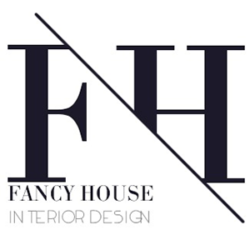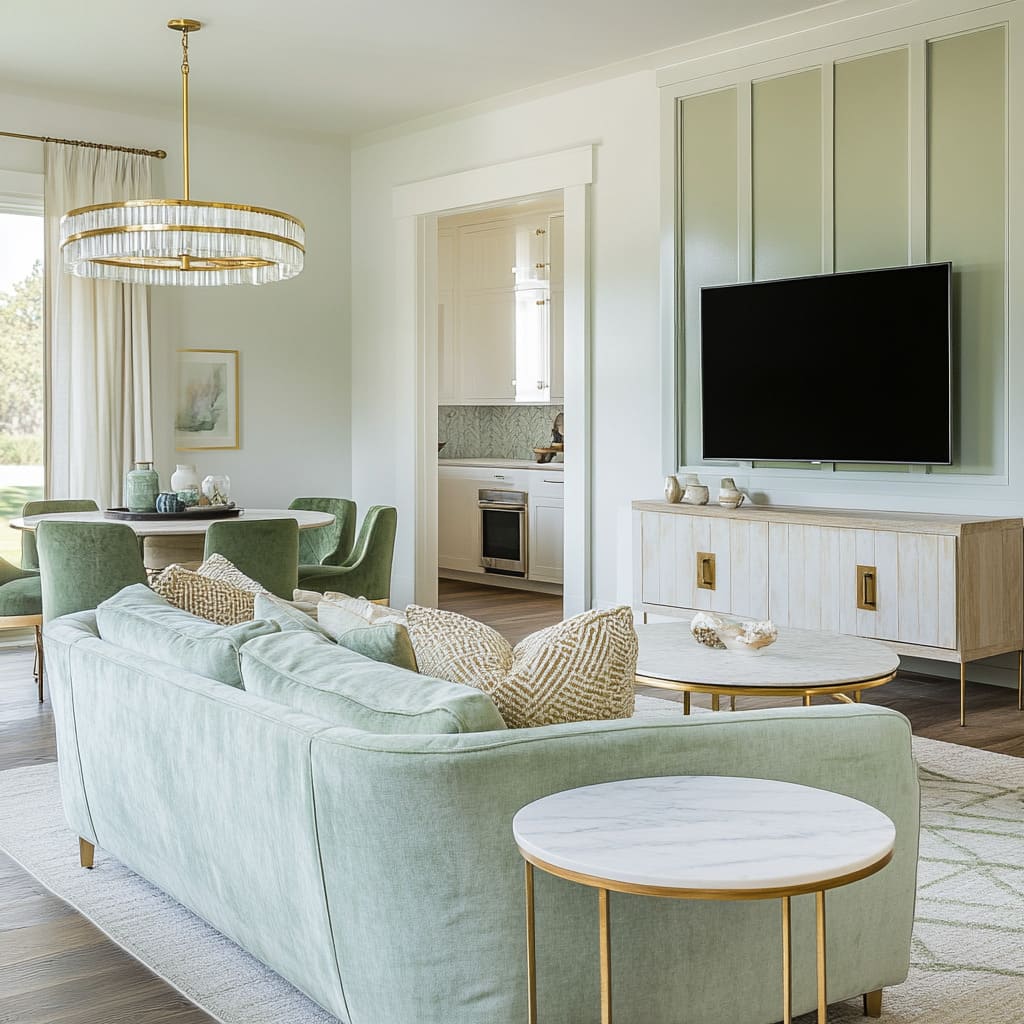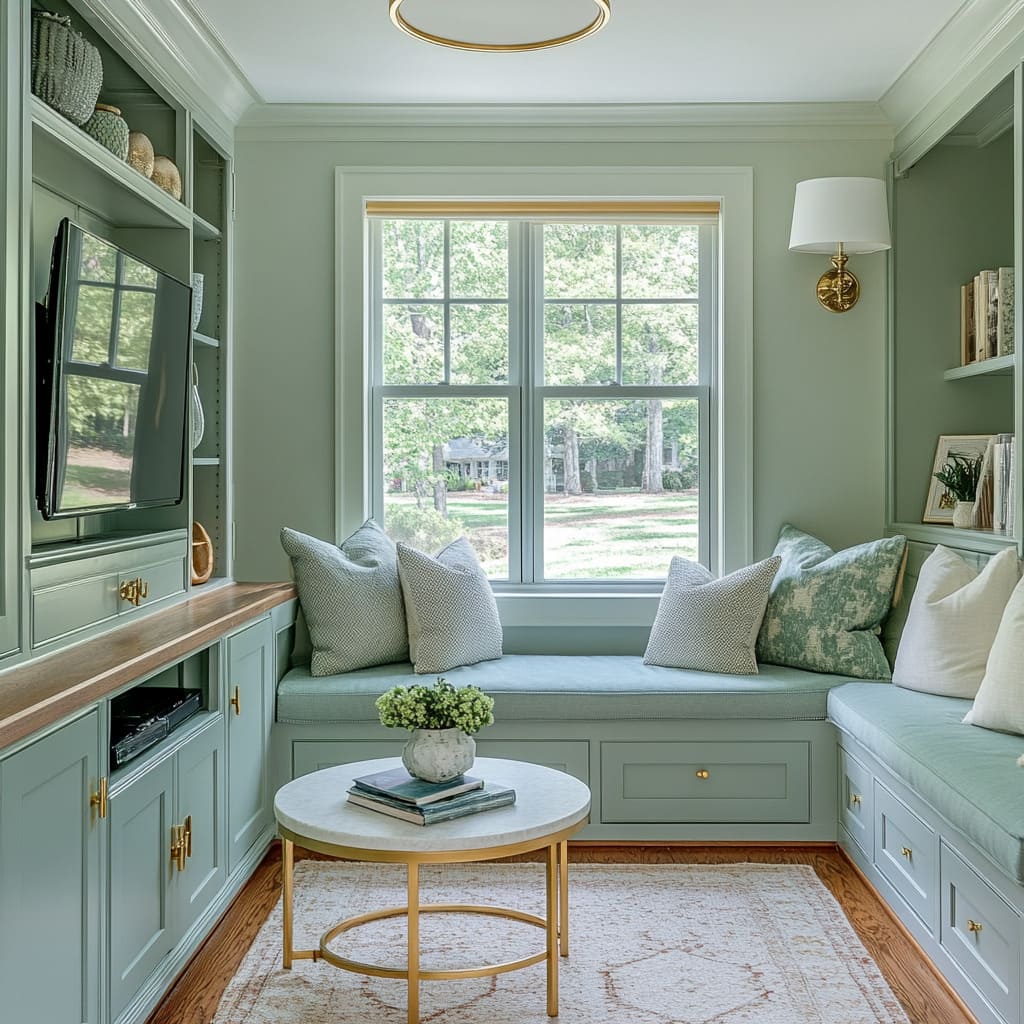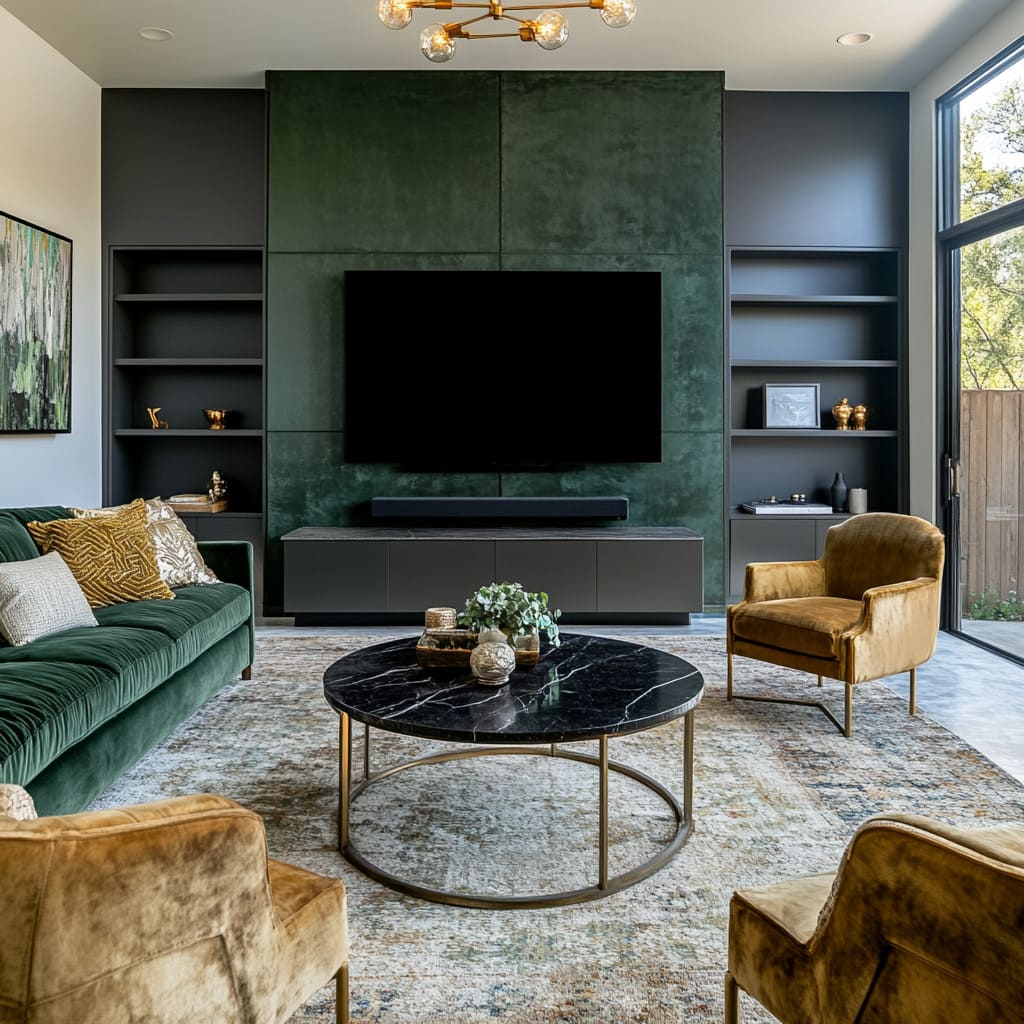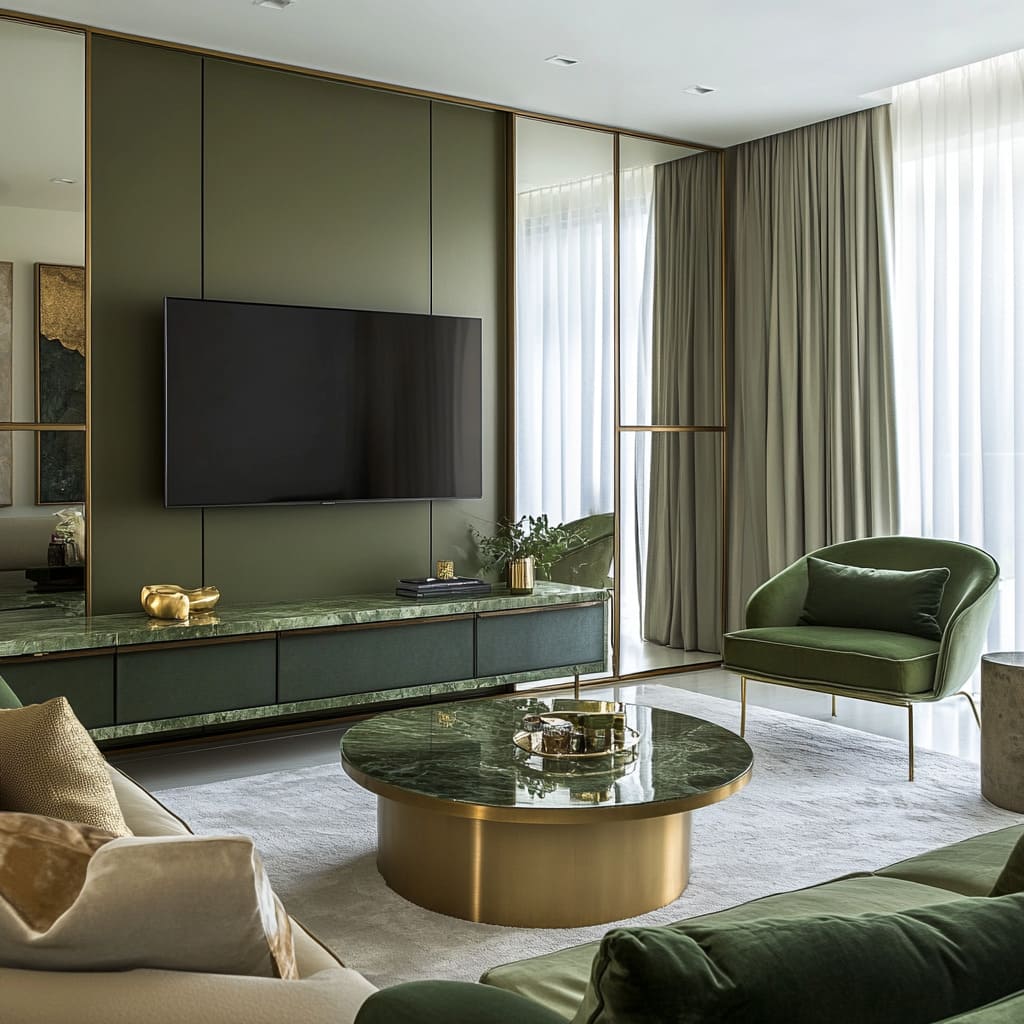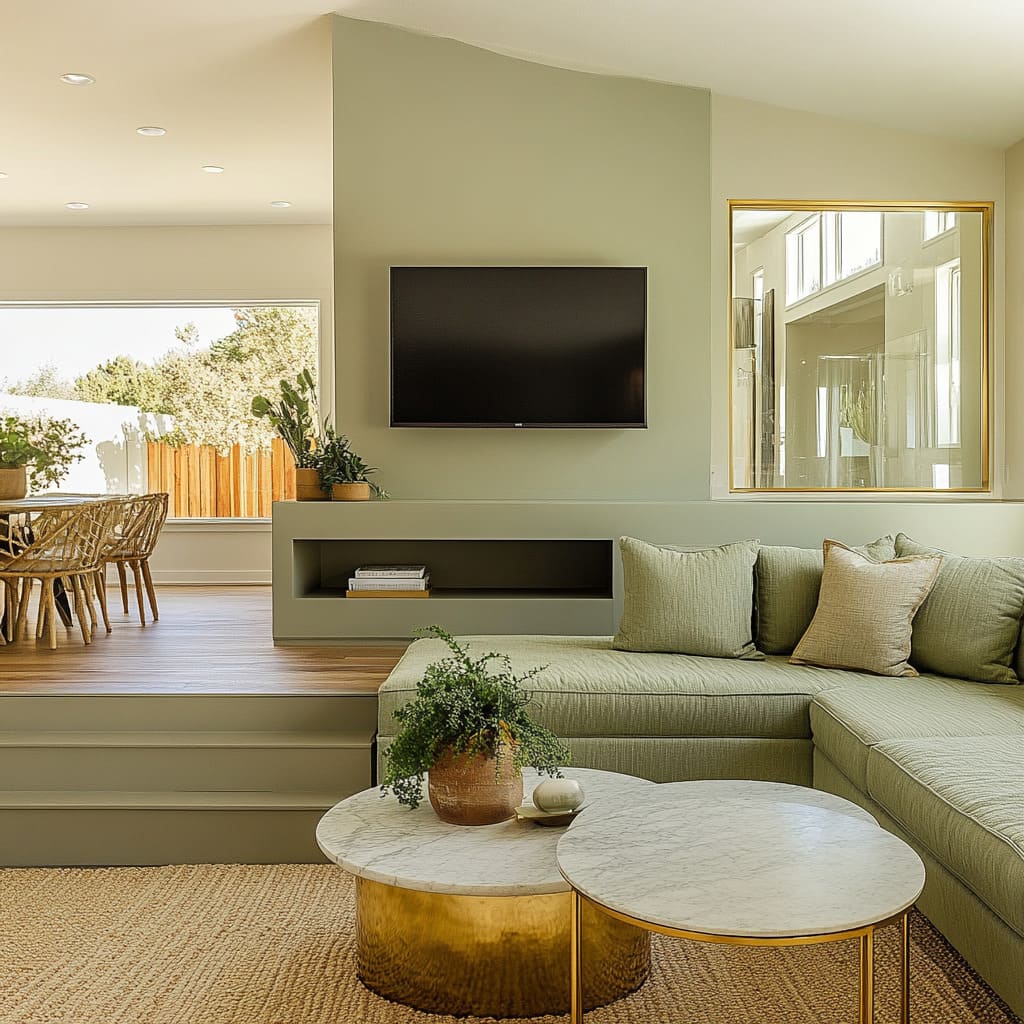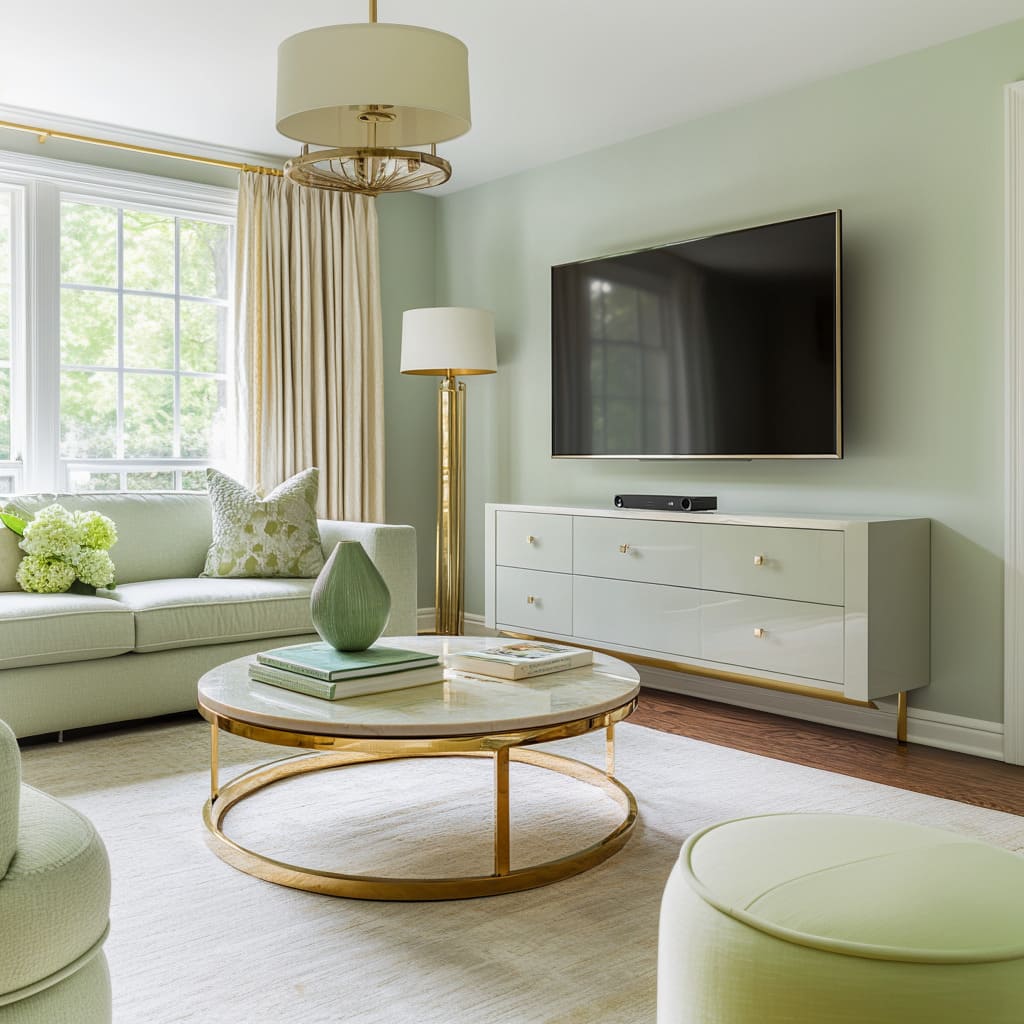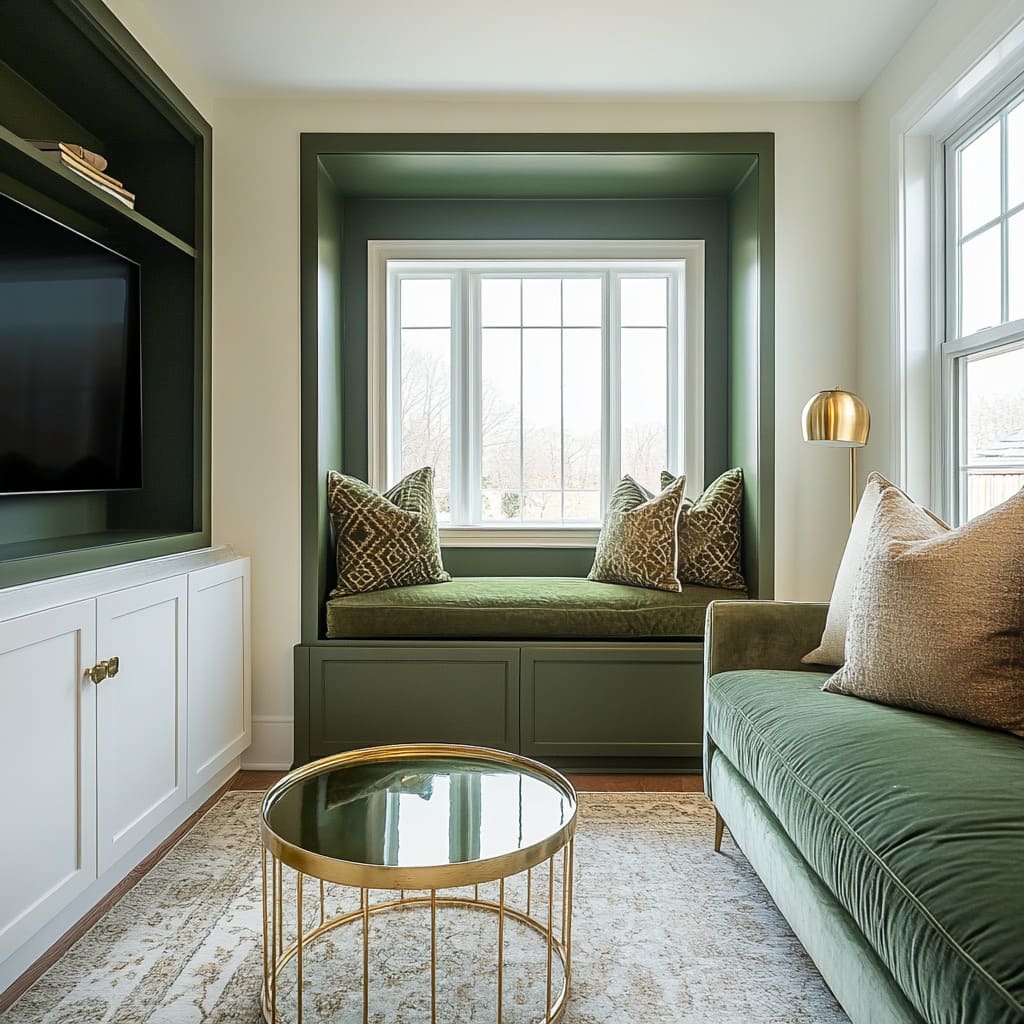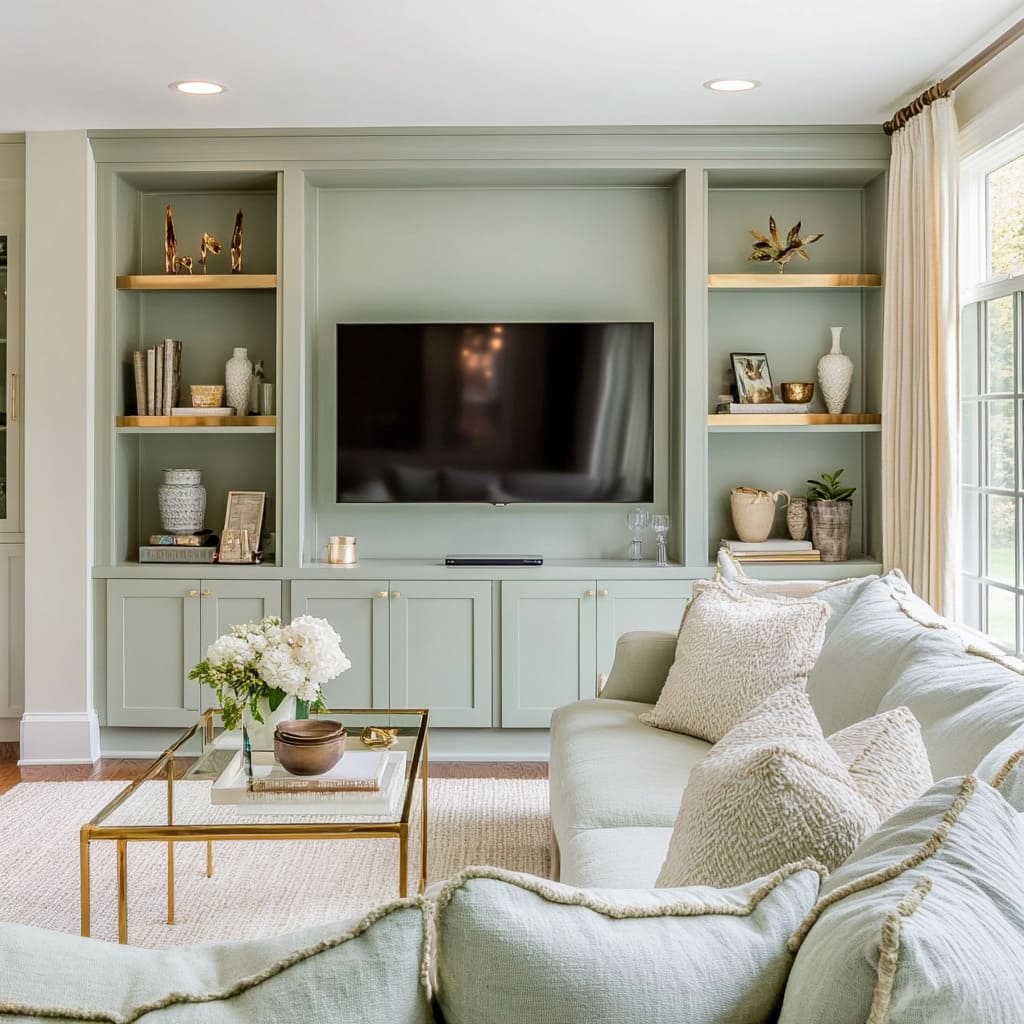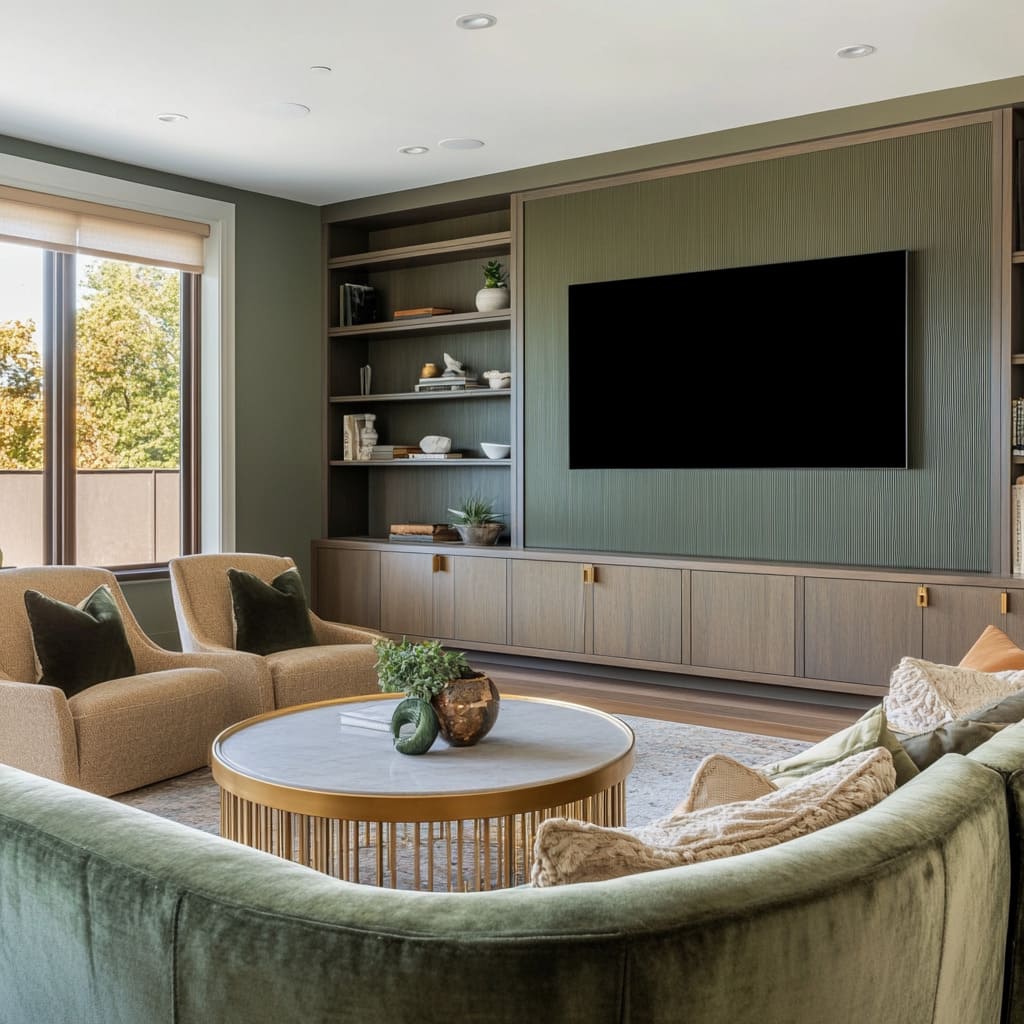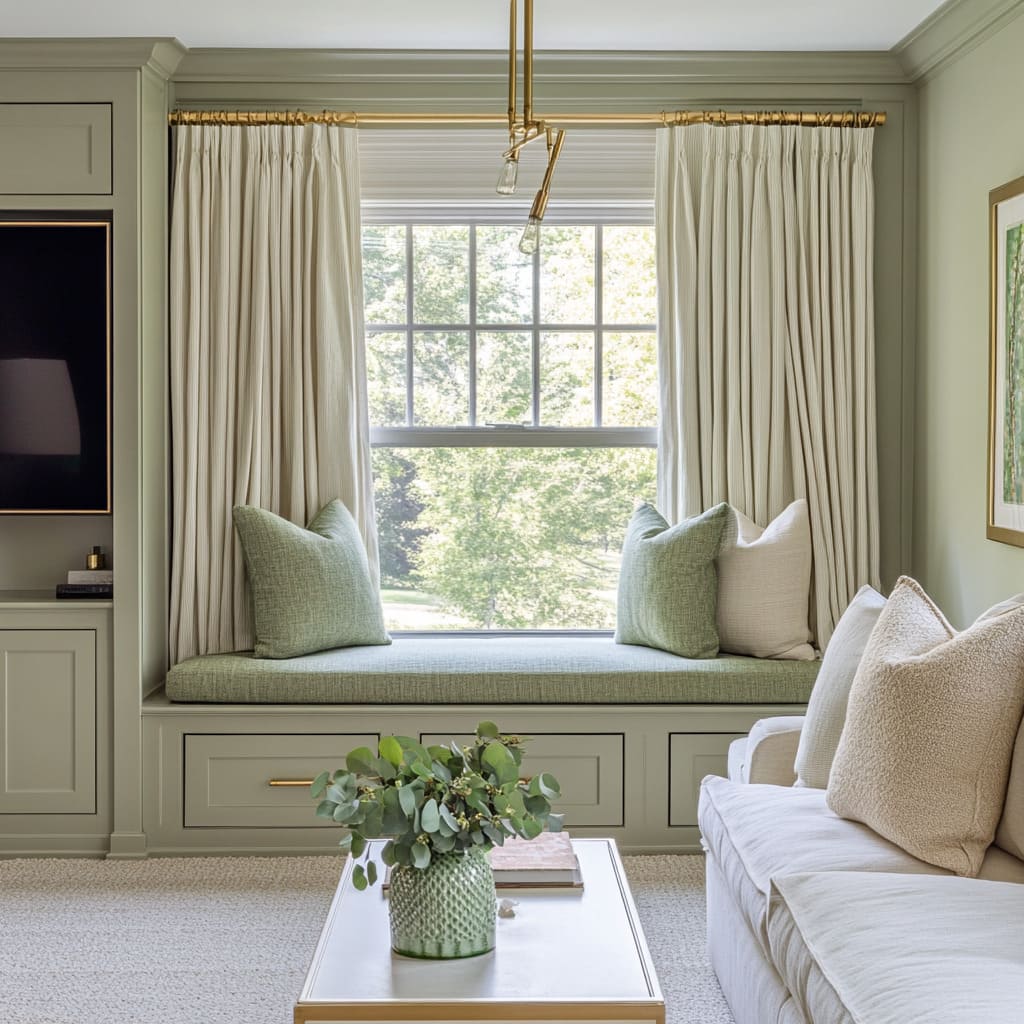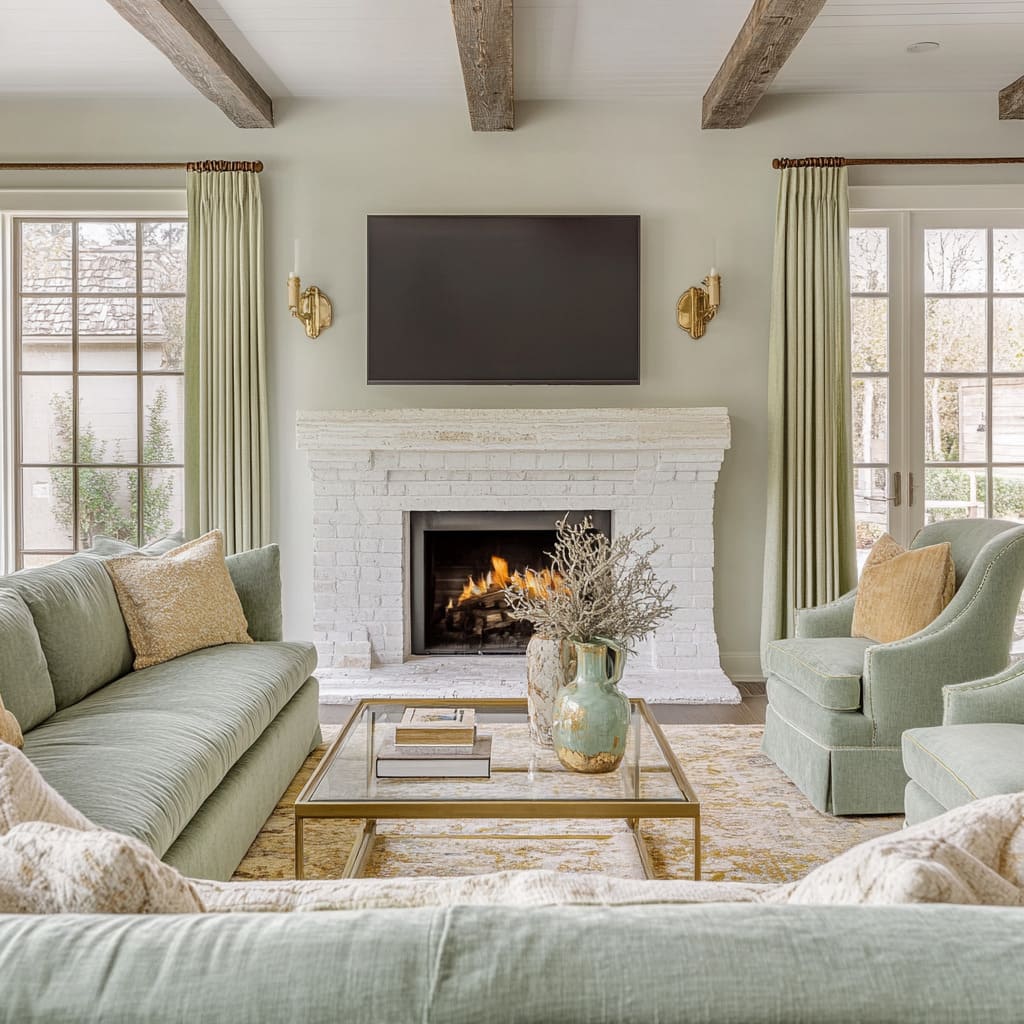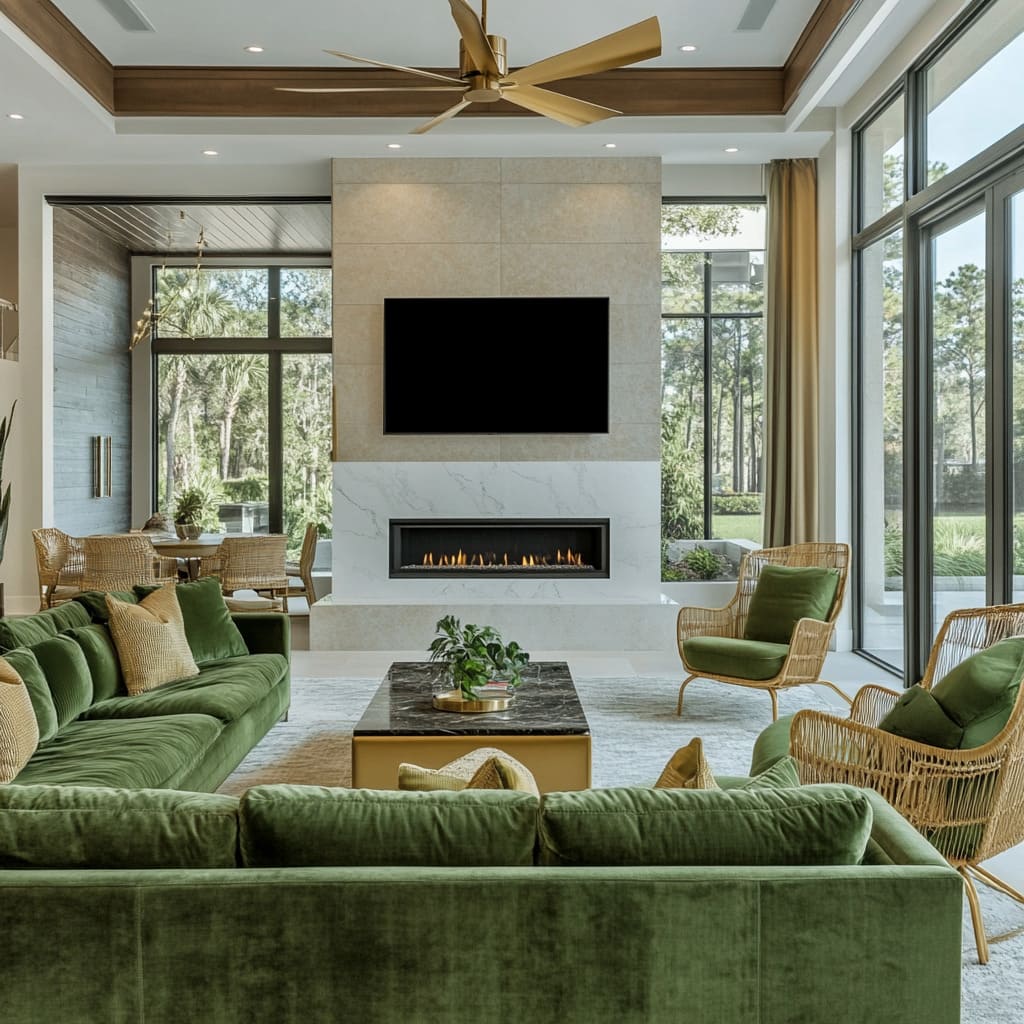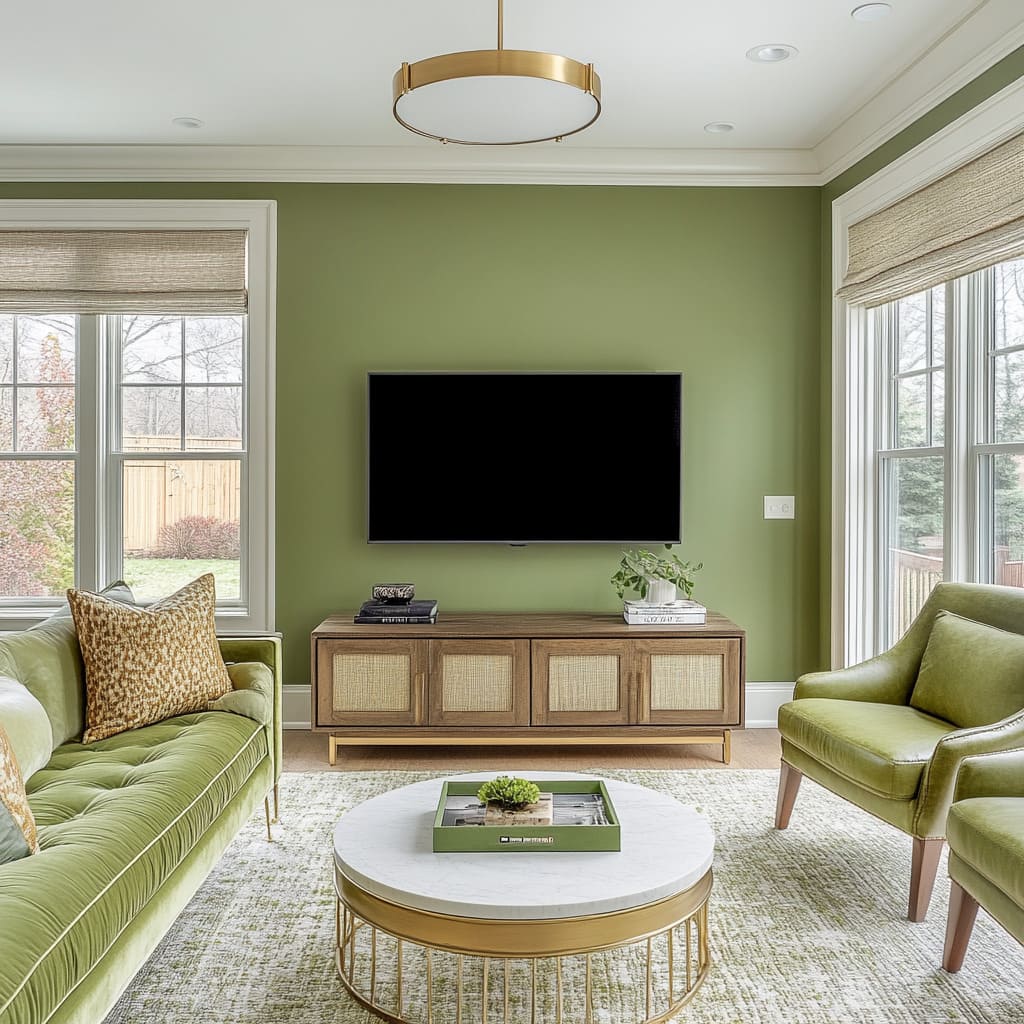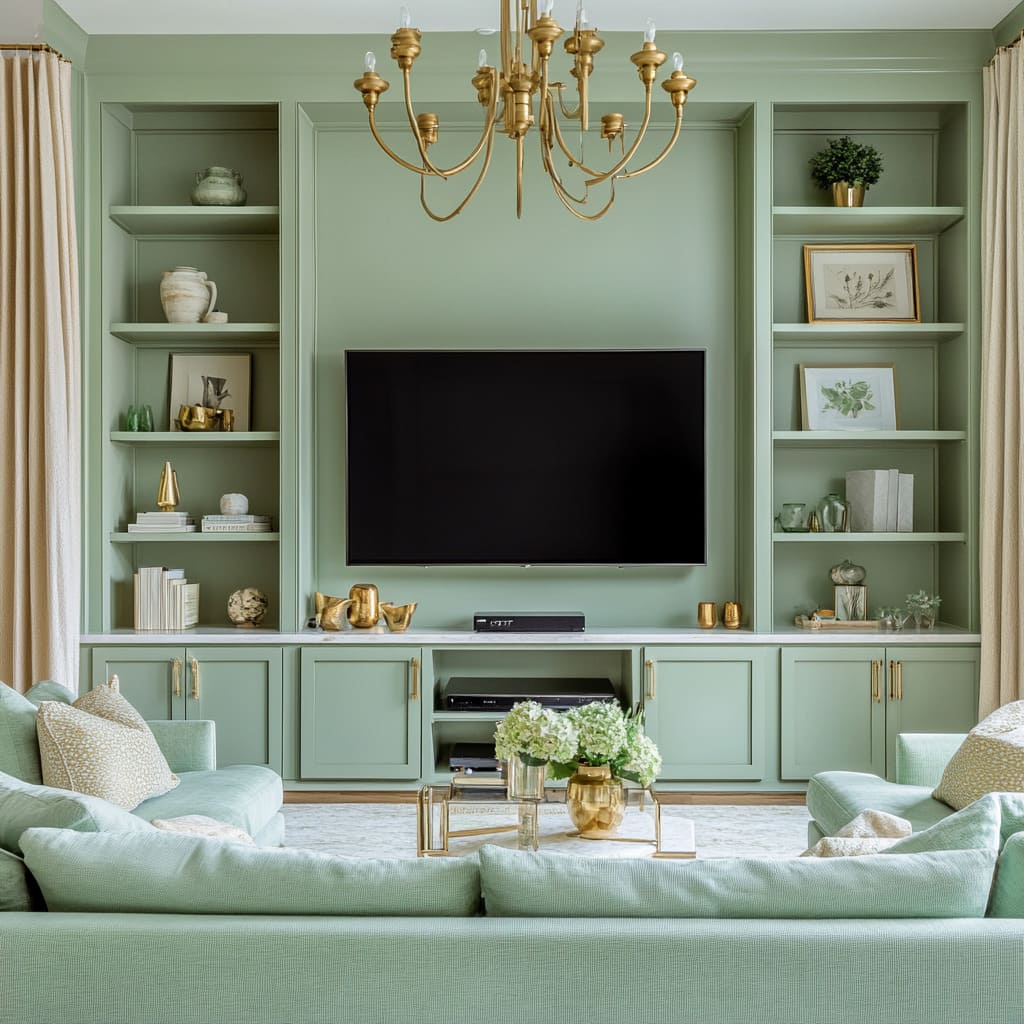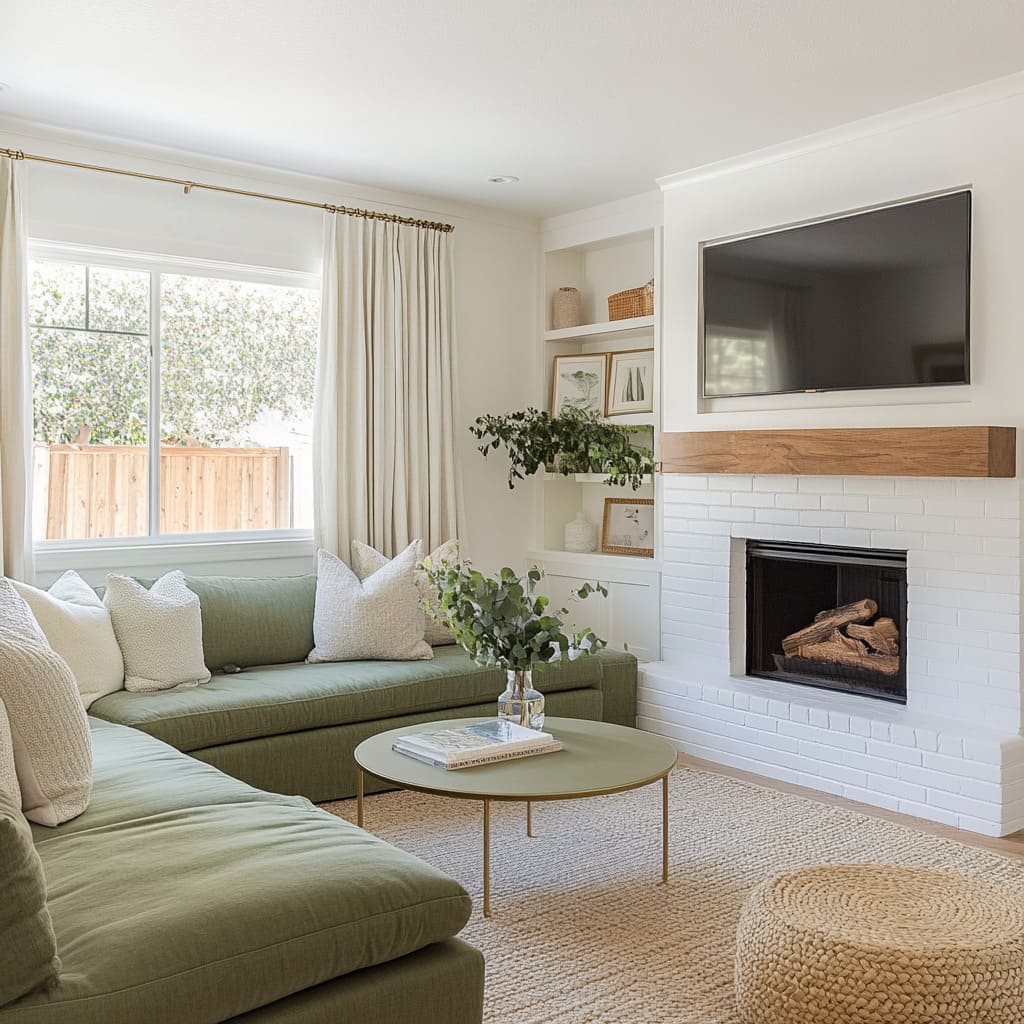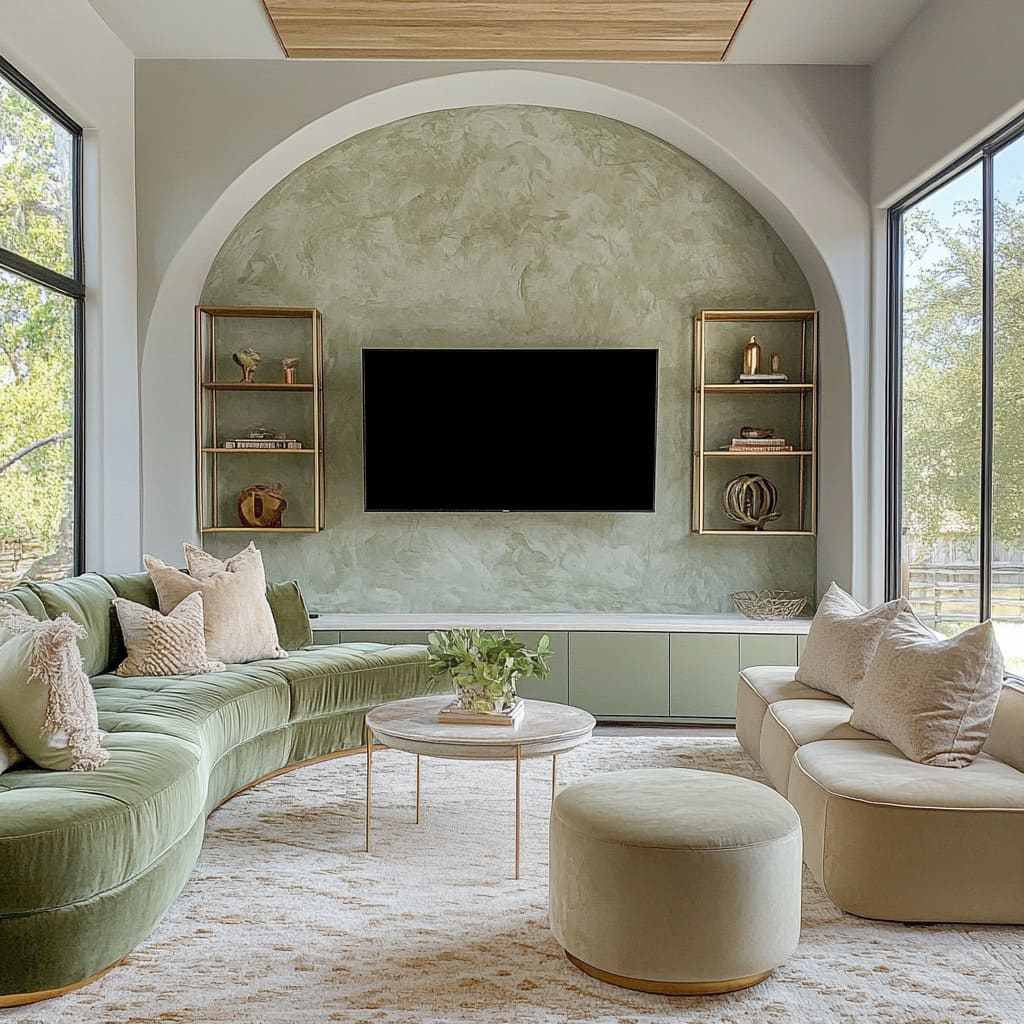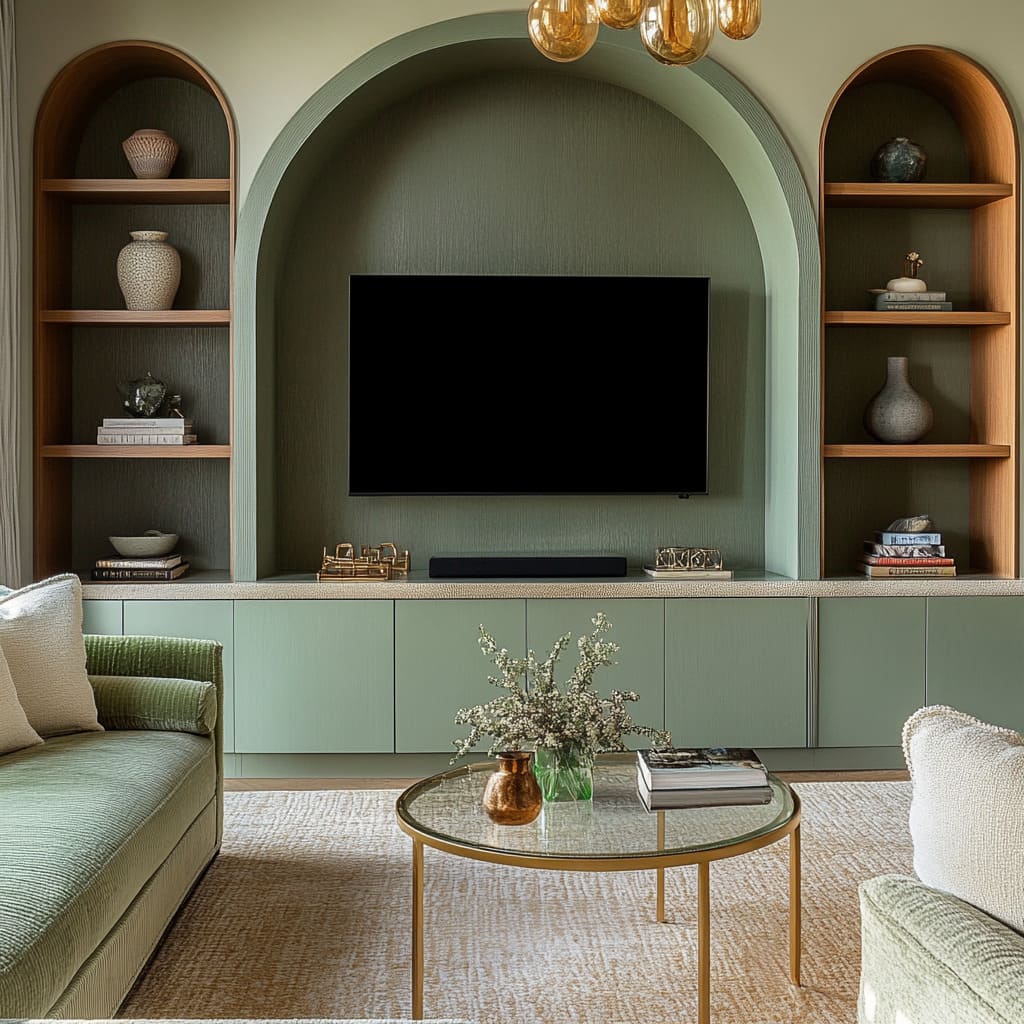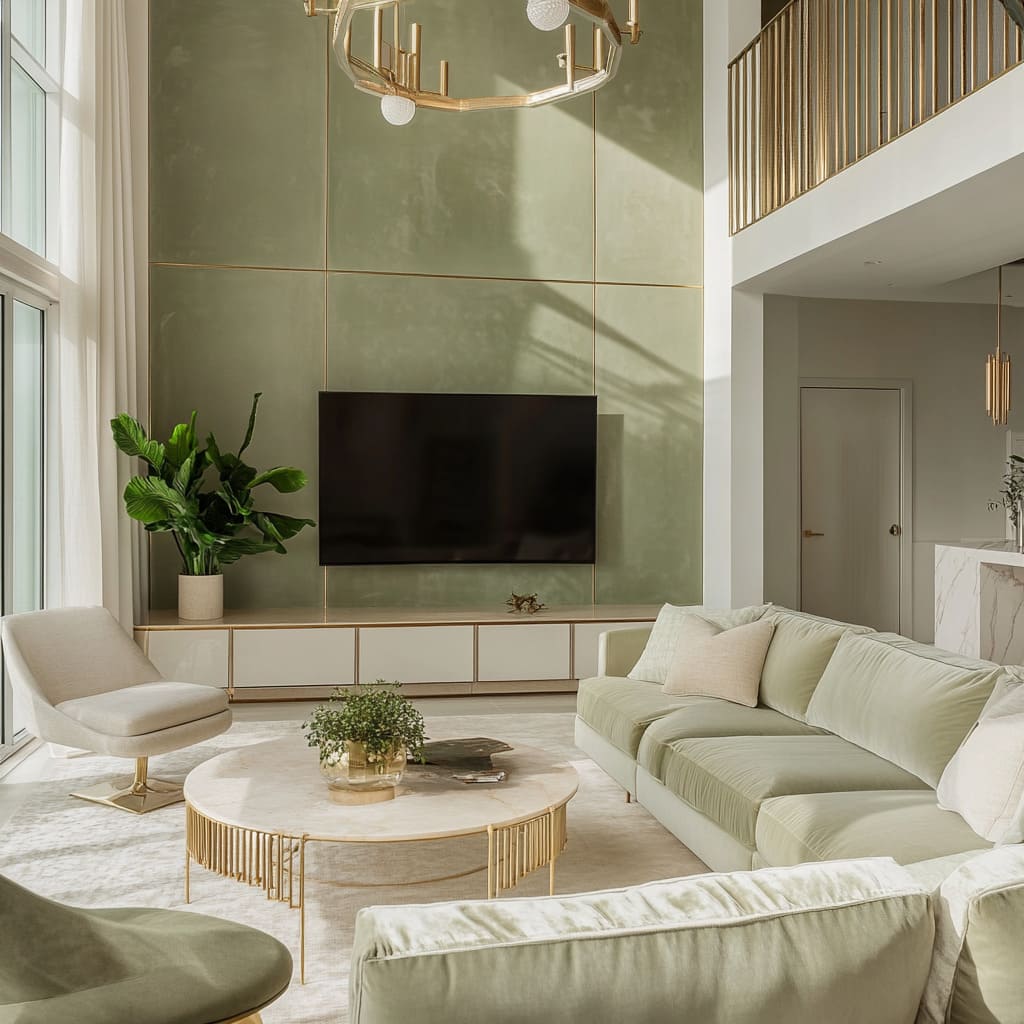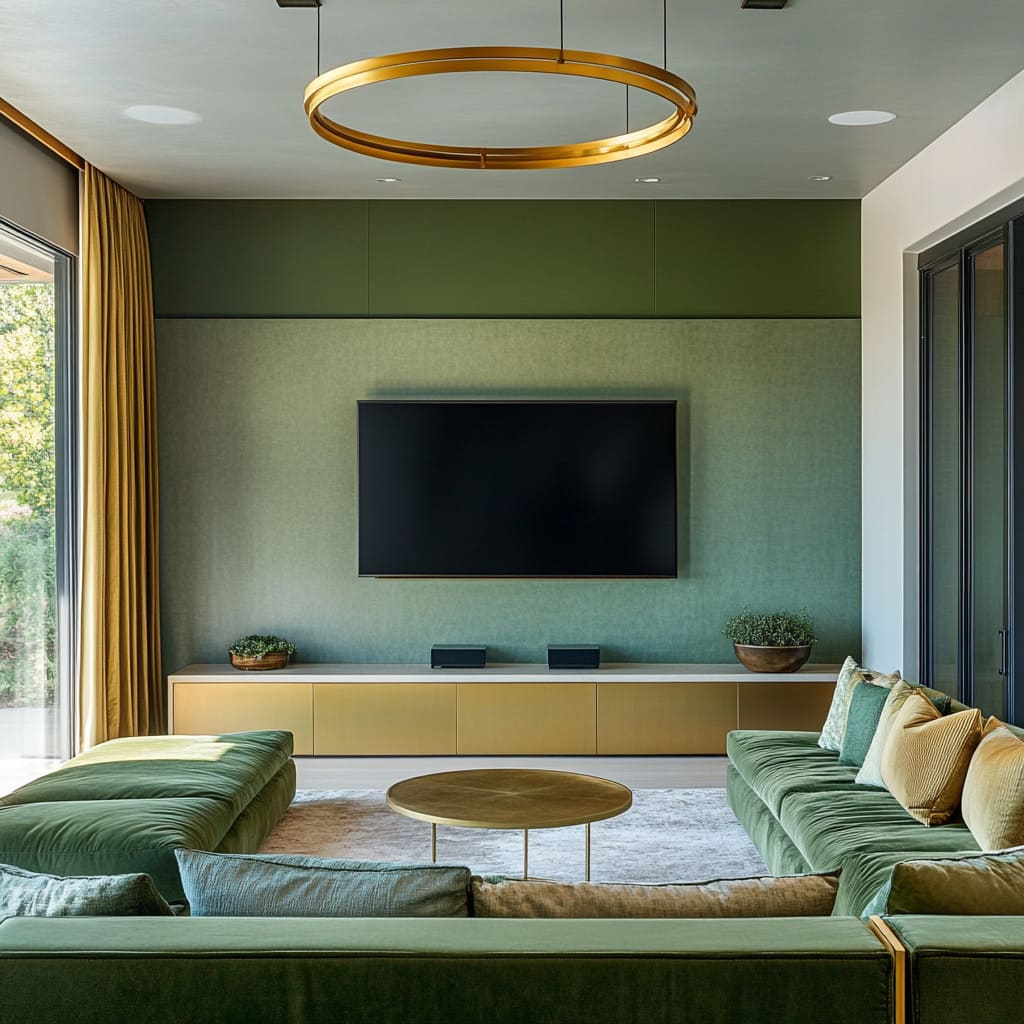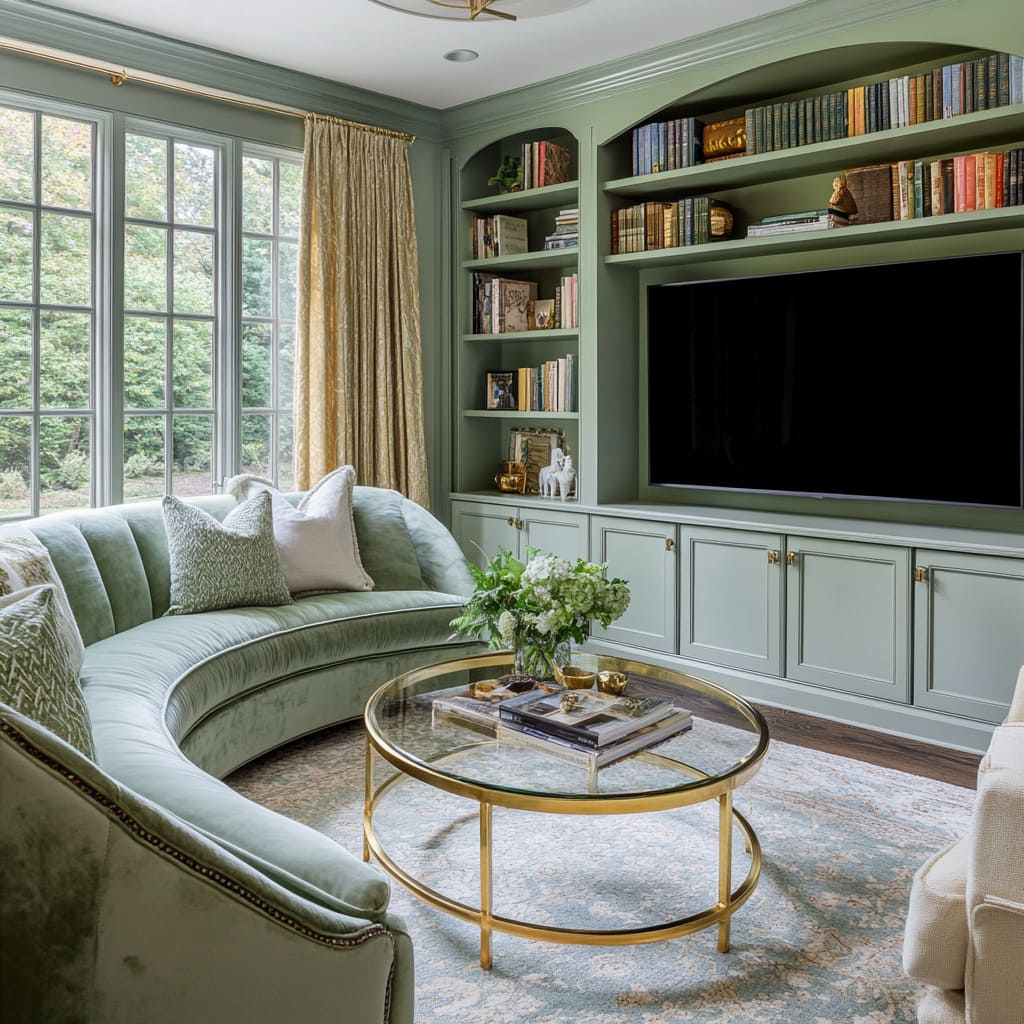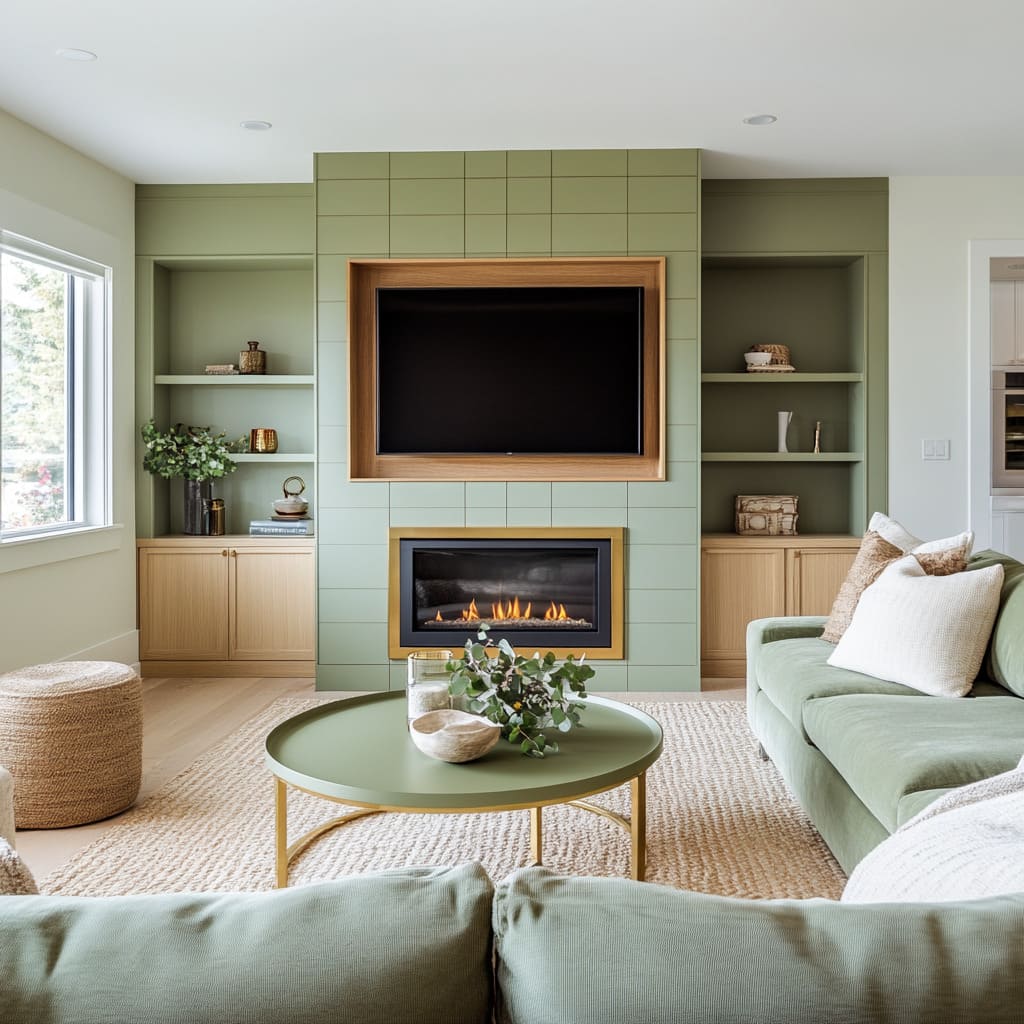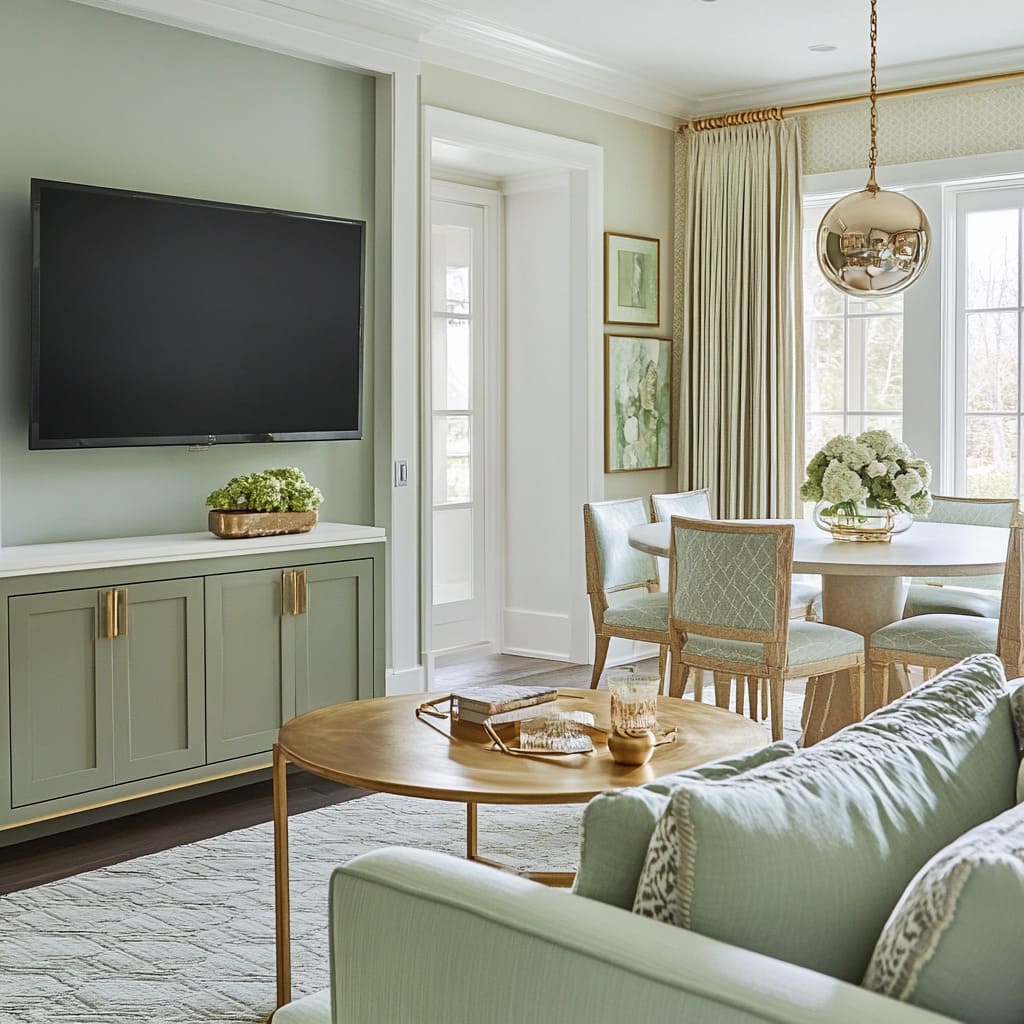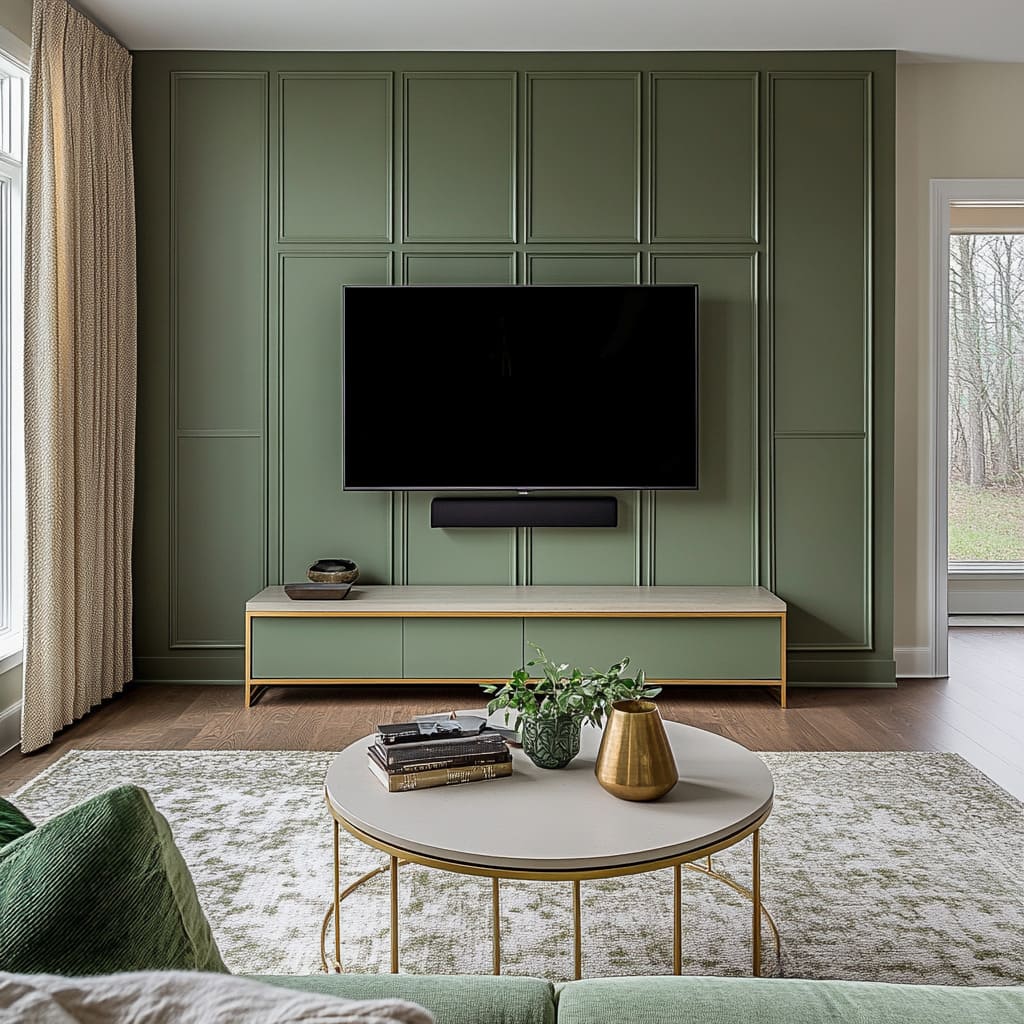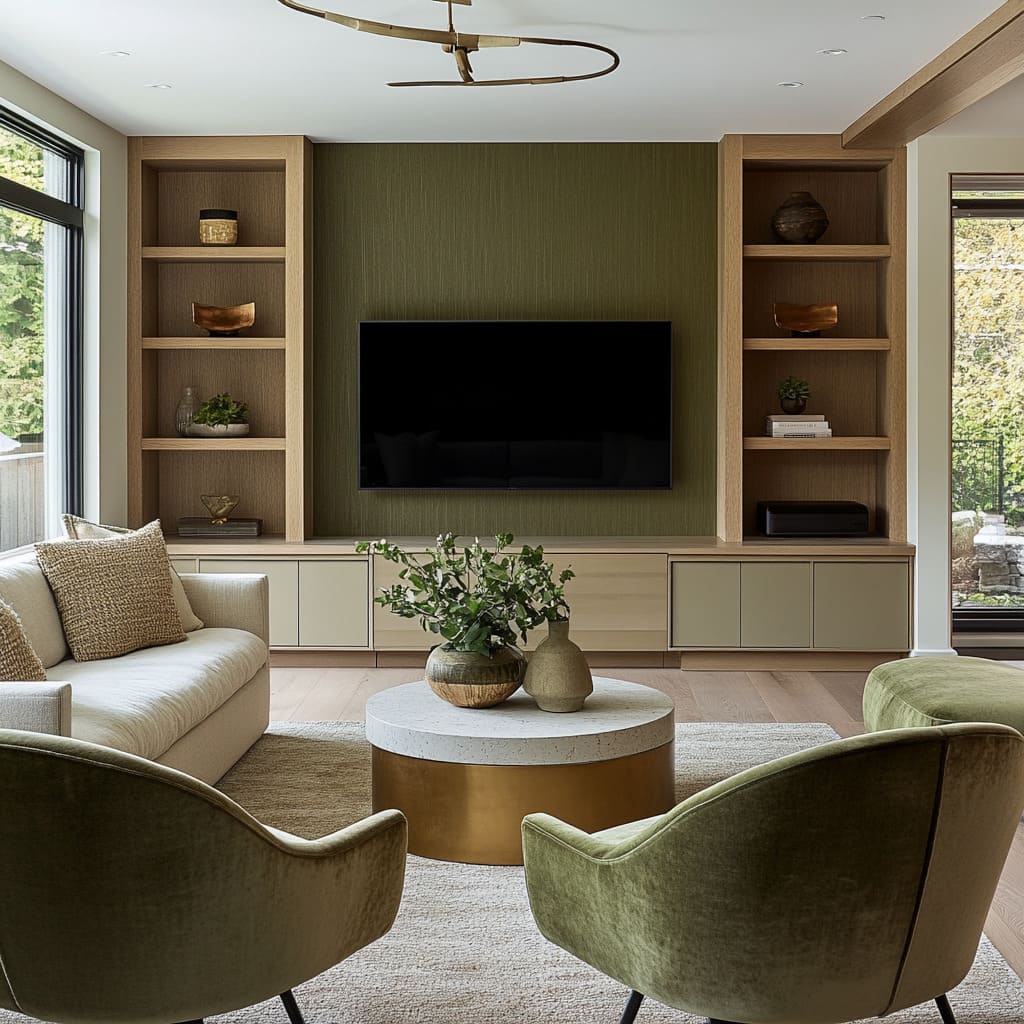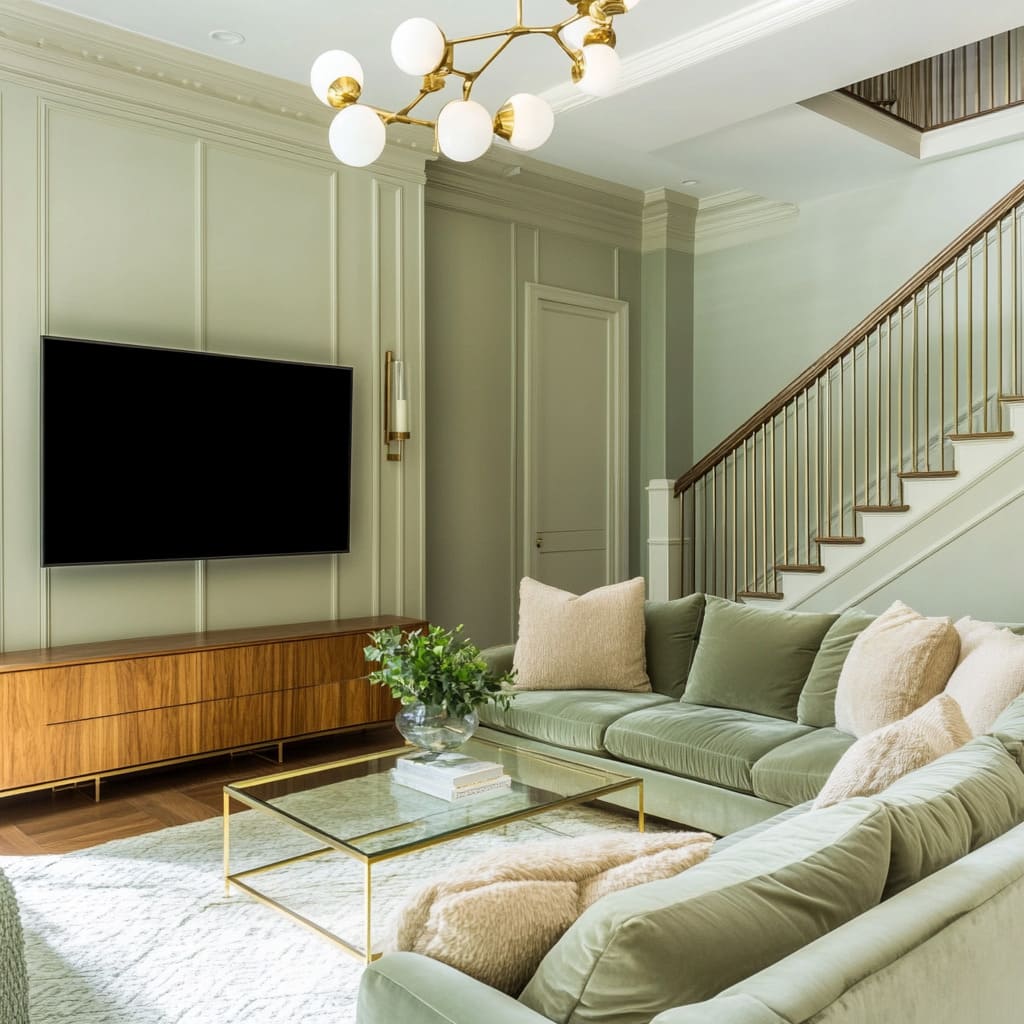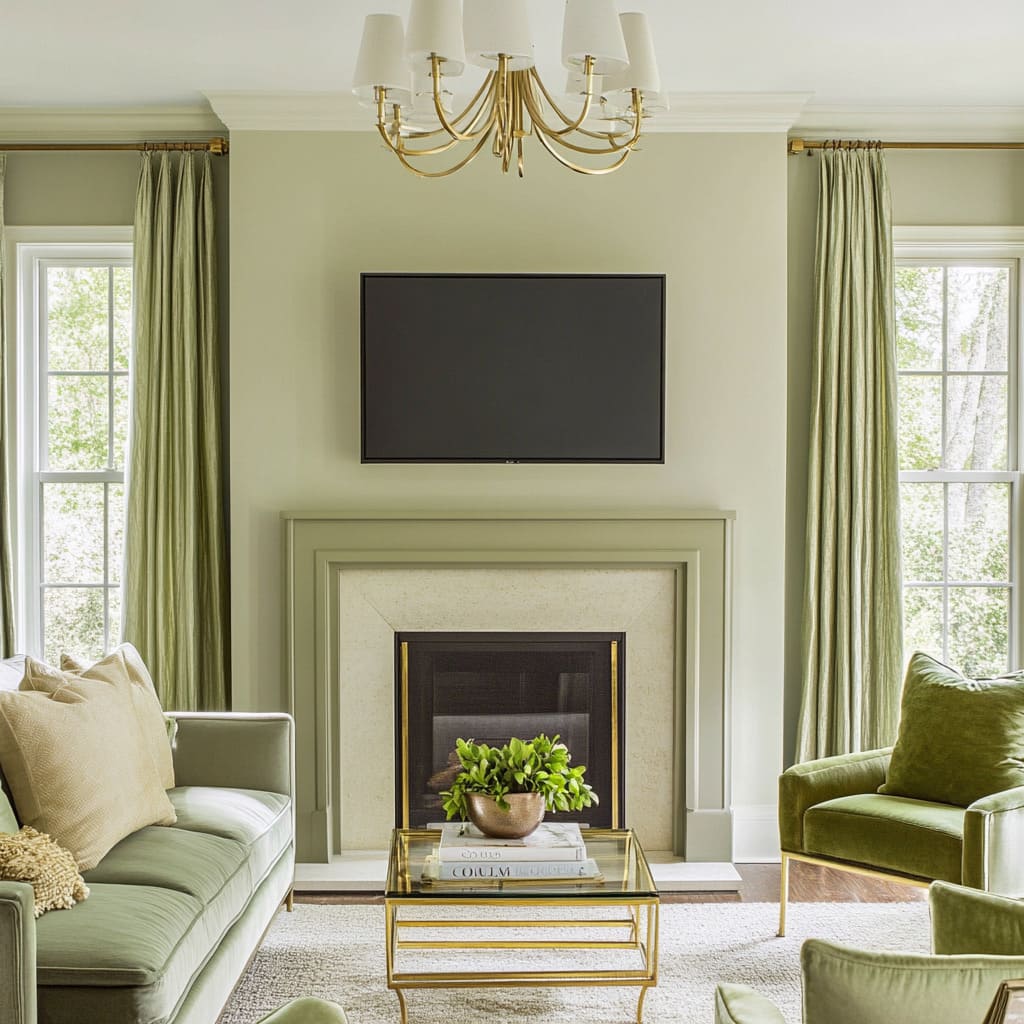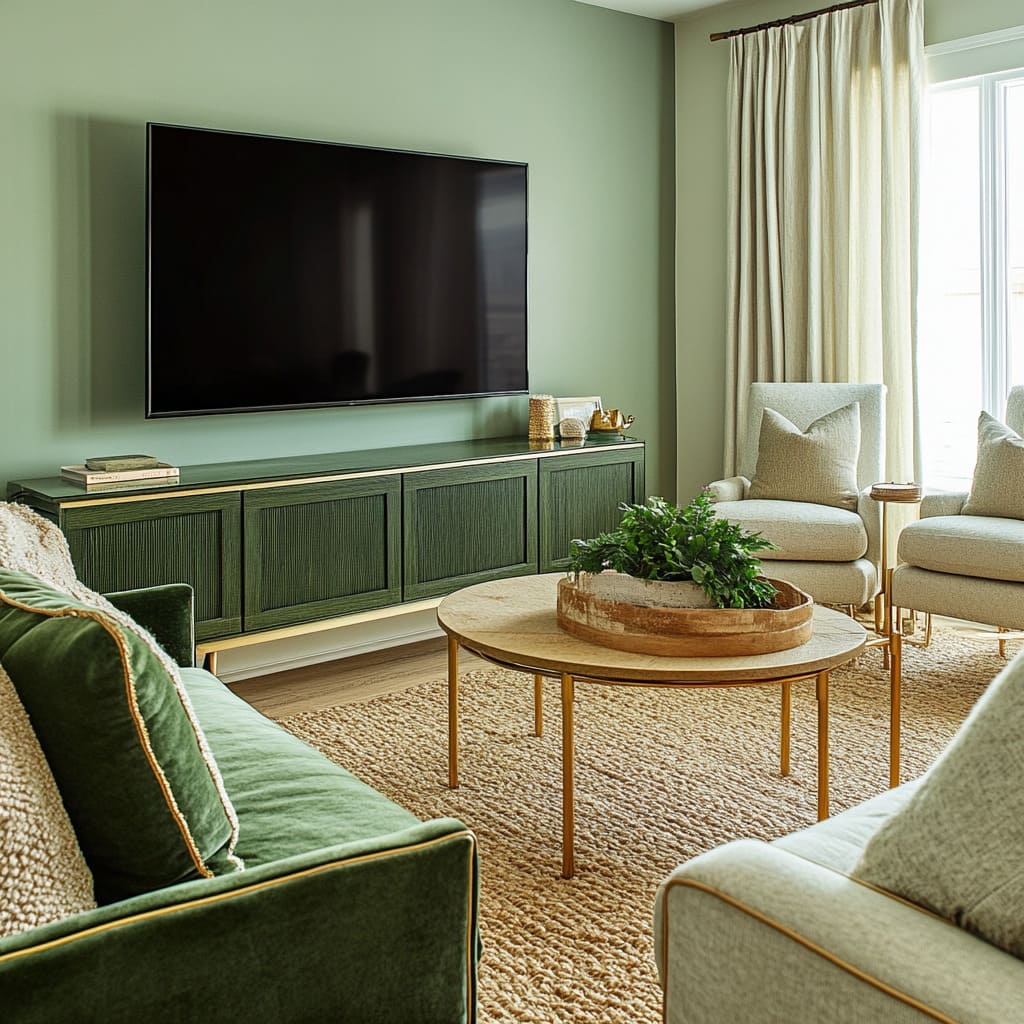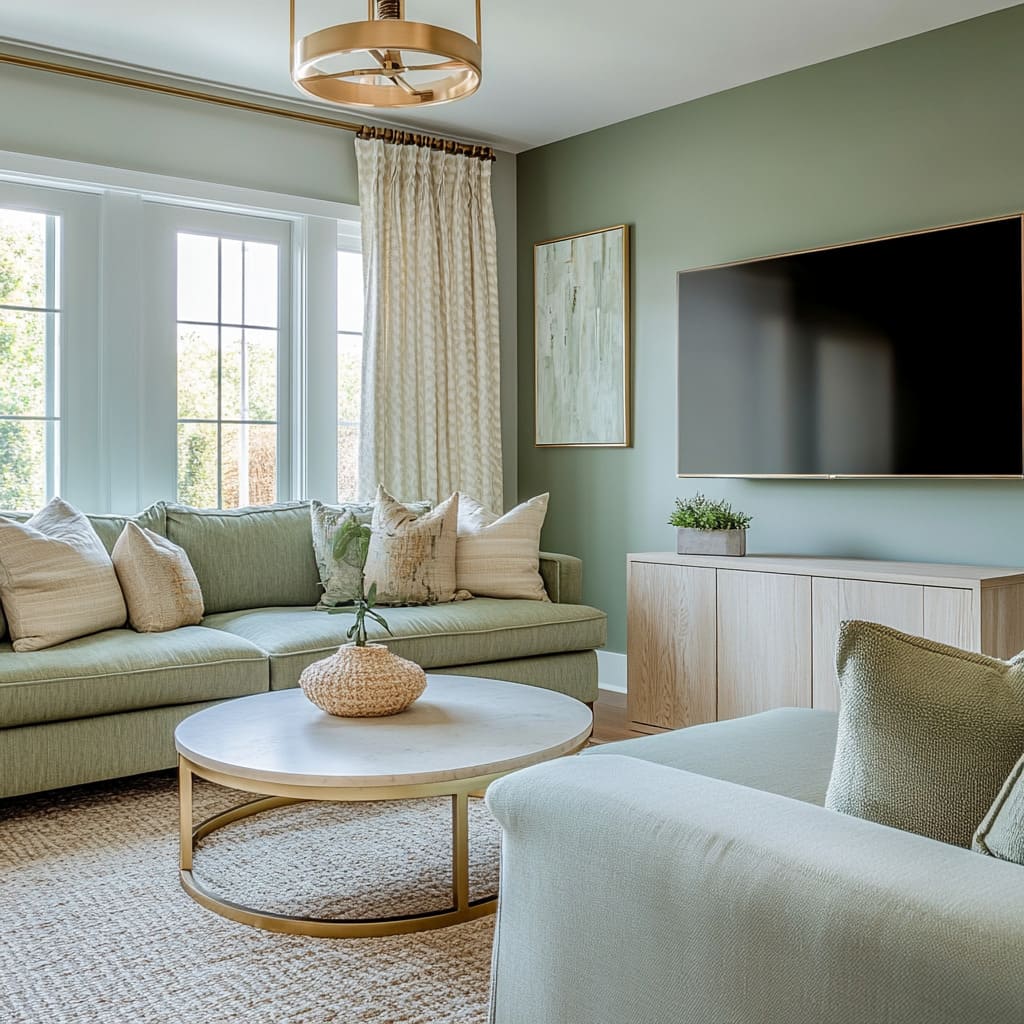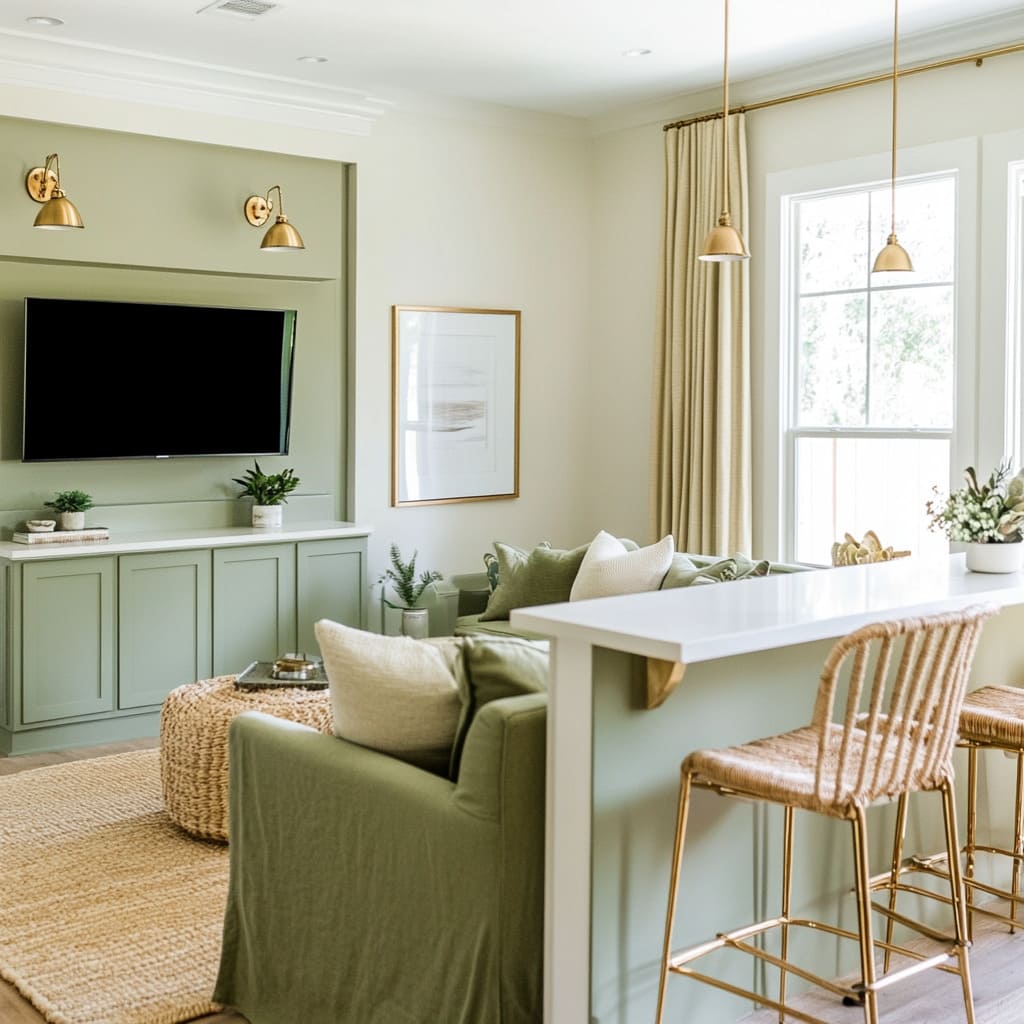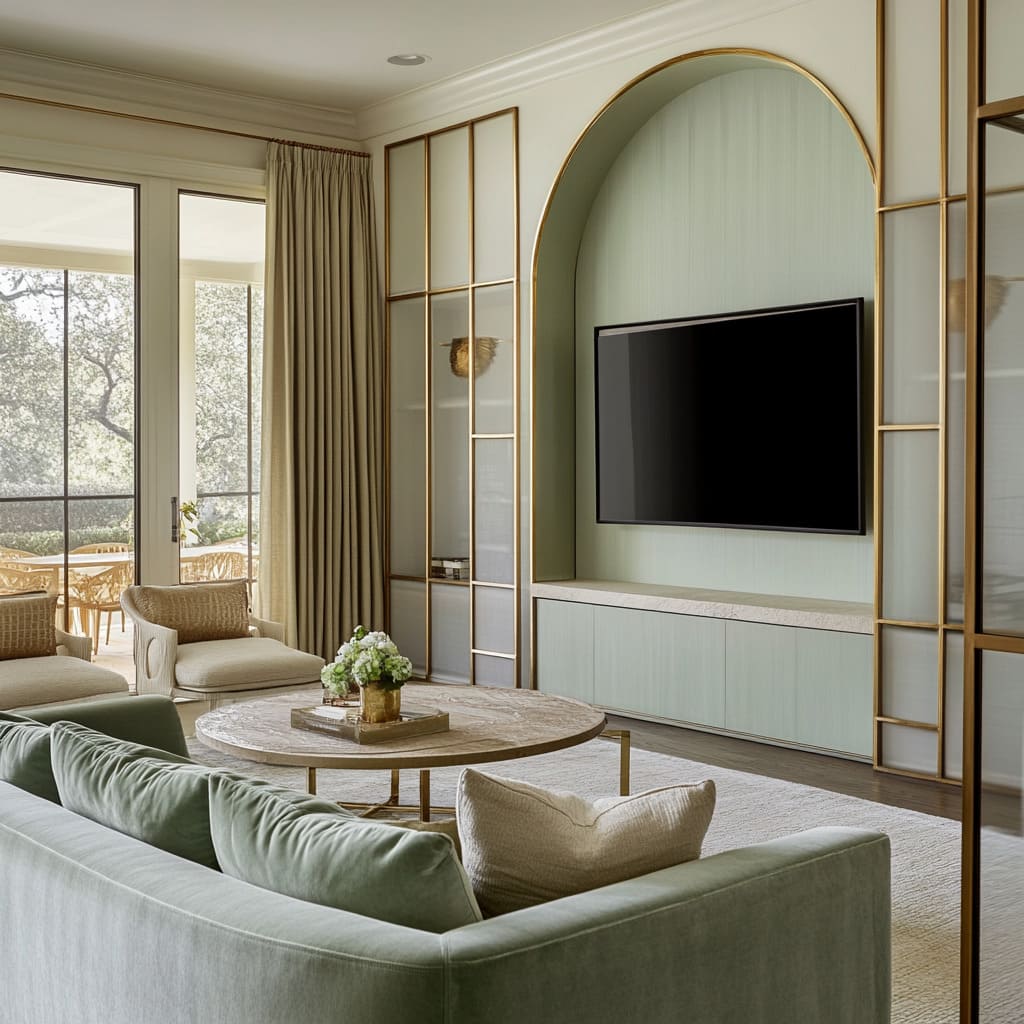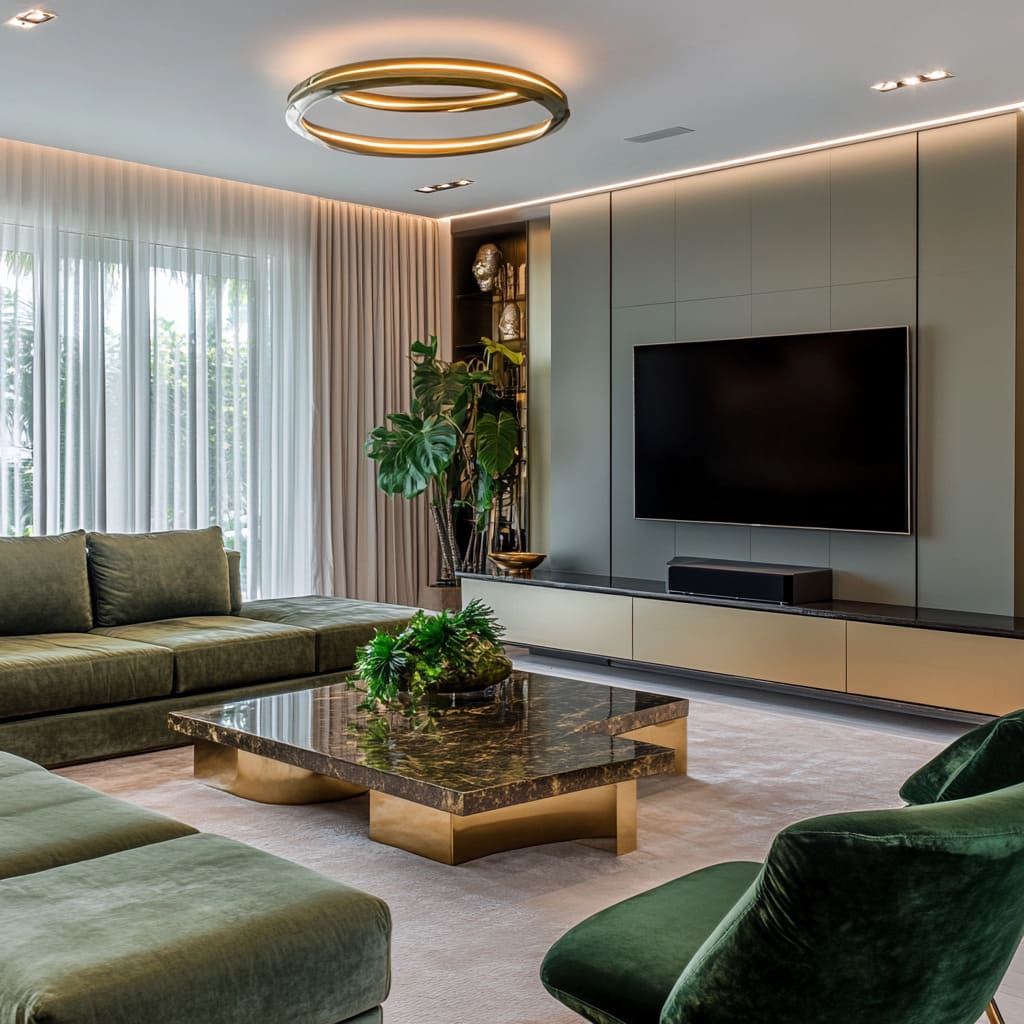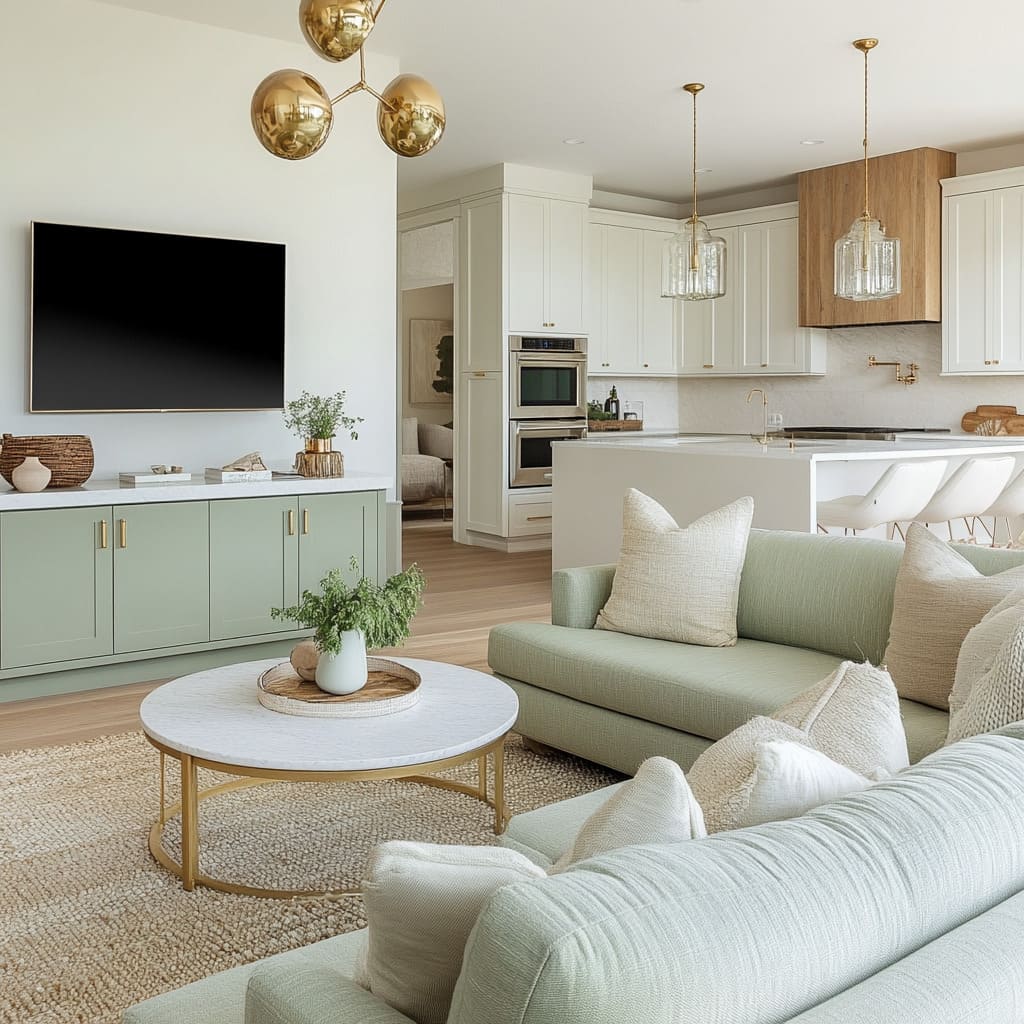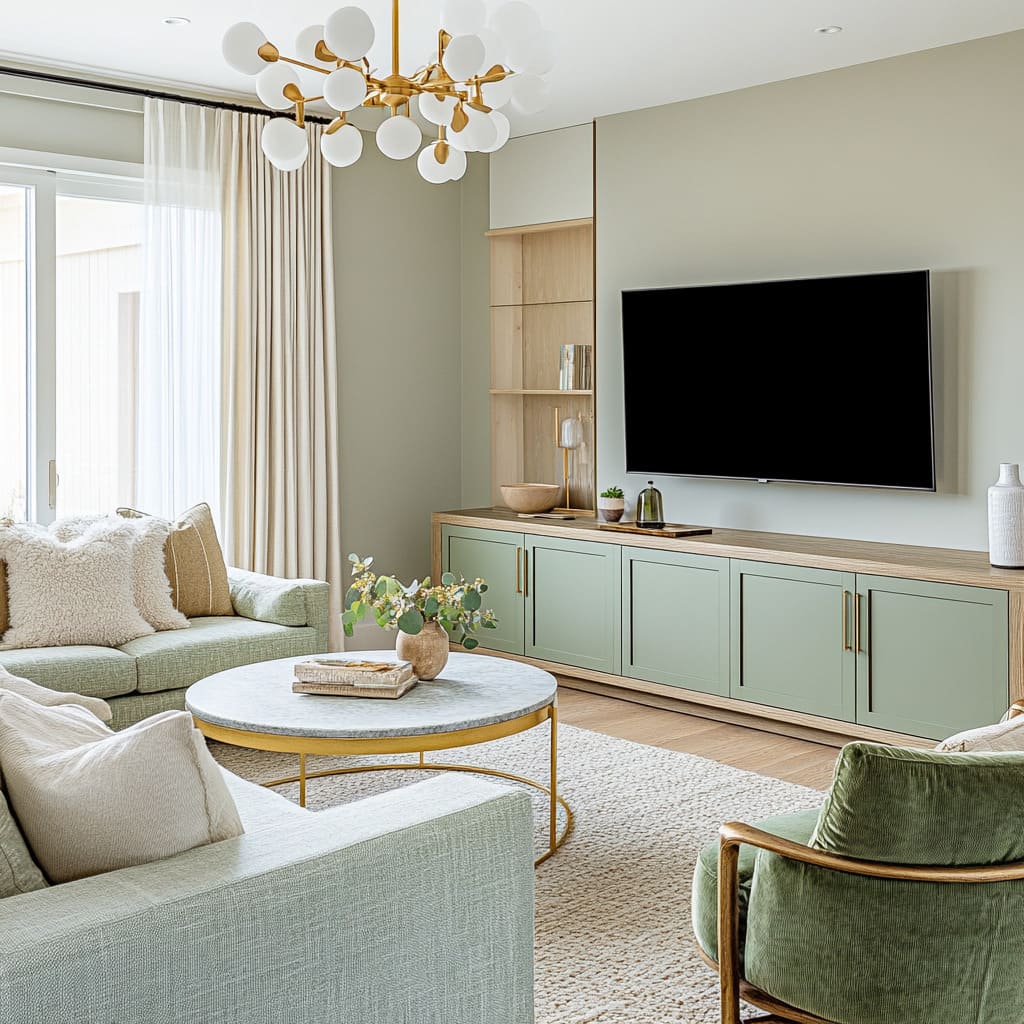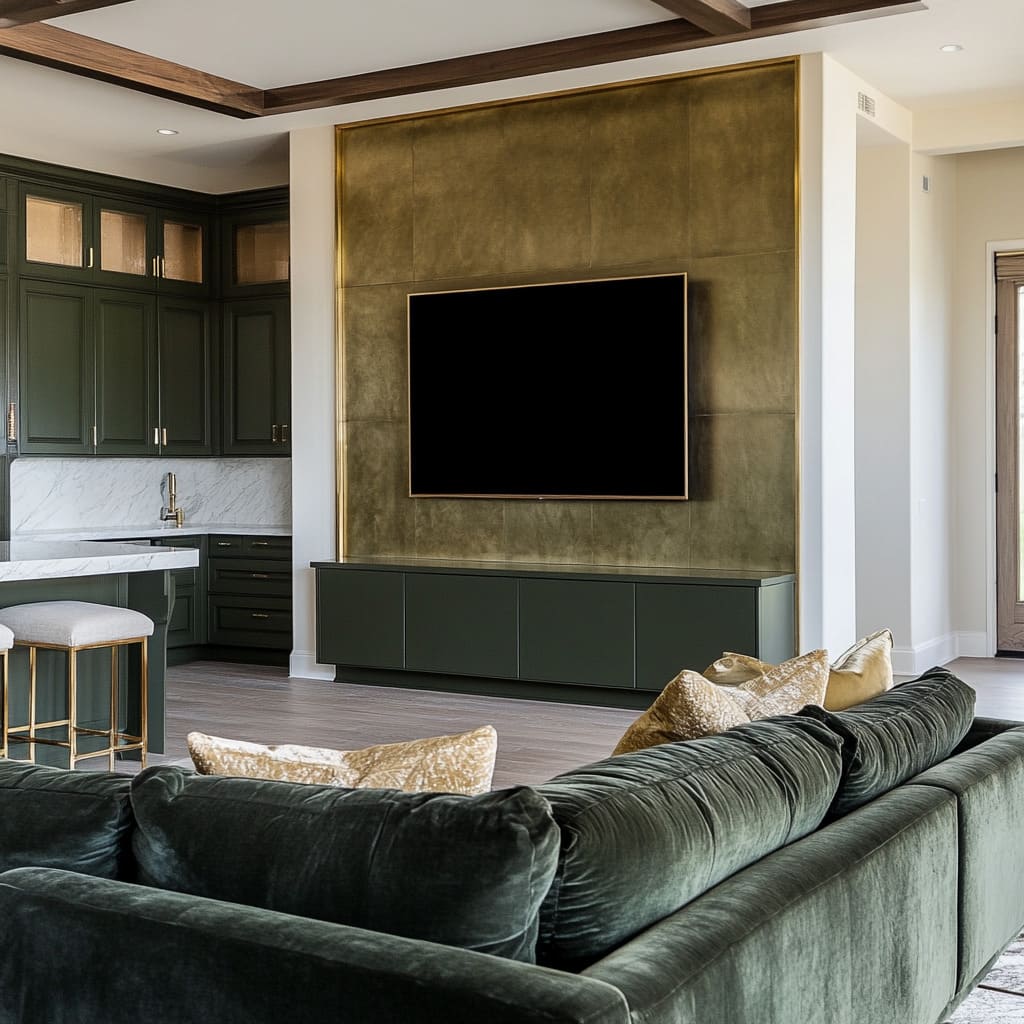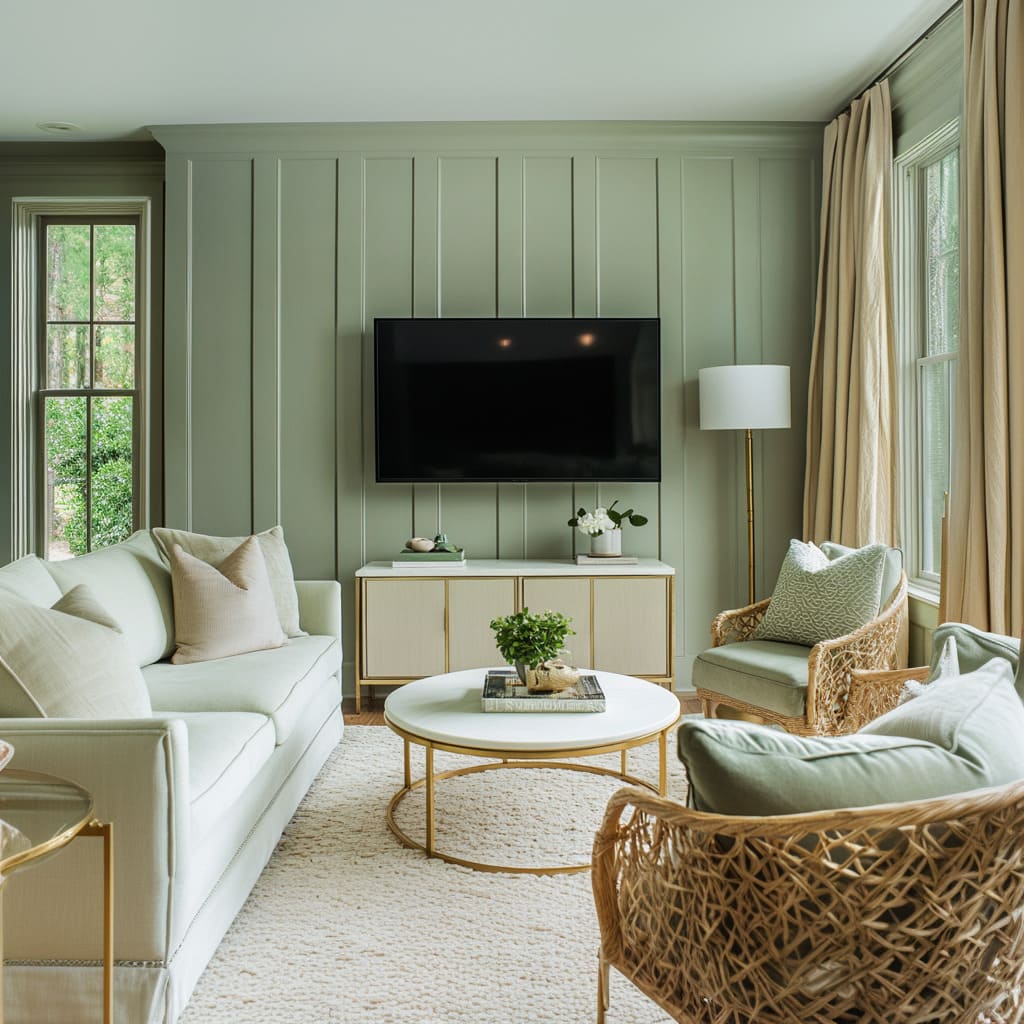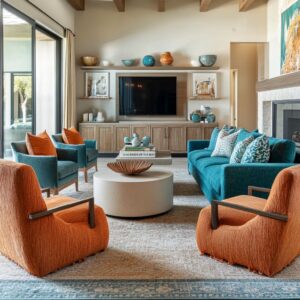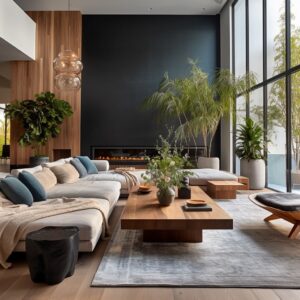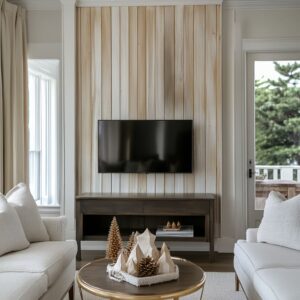Green and gold have long been a go-to combination for interiors that balance warmth with refinement. But beyond the obvious—green’s natural, calming effect and gold’s ability to bring in a touch of luxury—there’s much more happening in well-designed spaces that use these colors.
This article takes a closer look at the details that often go unnoticed, revealing how small adjustments in shades, finishes, textures, and layout can completely change the way this color scheme feels in a room.
Rather than focusing on broad trends or repeating standard advice about pairing green with gold accents, this deep dive explores the subtleties that set exceptional interiors apart. From how lighting shifts green tones throughout the day to the way different gold finishes can either blend in or stand out, we’ll go beyond surface-level decorating tips.
You’ll also find unexpected ways to integrate these colors—through architectural details, layering different greens, and mixing textures to create a more nuanced look. Green-and-gold living rooms can take many forms, from classic and vintage-inspired to modern and dramatic.
The goal isn’t just to match colors but to create a space that feels cohesive, balanced, and full of depth. Whether you’re drawn to soft sage and brushed gold for a calming effect or prefer deep forest green with polished brass for a more striking contrast, the insights here will help you refine your space with thoughtful details that make a lasting impact.
Choosing the Right Gold Finish: A Key to a Balanced Green and Gold Living Room
Gold may seem like a straightforward choice, but the finish you select can completely shift the mood of a green and gold living room. The way gold interacts with surrounding colors, light, and materials can make the difference between a space that feels rich and cohesive or one that looks mismatched.
Whether you’re aiming for understated refinement or a bold, polished look, understanding these subtle differences will help you create a more layered and intentional design.
Soft and Subtle: Champagne or Brushed Gold
For a refined and muted effect, champagne and brushed gold finishes offer warmth without overpowering the space. These work especially well with pale mint or sage walls, where a high-shine finish might feel too stark.
The softer glow of brushed metal allows gold to blend seamlessly into the background, creating a more organic look rather than an obvious contrast. This finish is a great option for curtain rods, light fixtures, and cabinet hardware if you want to keep the overall aesthetic light and airy.
Aged and Timeless: Antique Gold
For those who love interiors with depth and character, antique gold is an excellent choice. This finish has a slightly muted, patinated quality that works beautifully with weathered wood, vintage-inspired decor, or classic architectural elements.
It’s particularly effective in rooms with slightly distressed furniture, as it enhances the warmth of natural materials. Pairing antique gold with deeper sage or muted olive tones can create a setting that feels layered and timeless rather than overly polished.
Bold and Contemporary: Polished or Mirrored Gold
On the other end of the spectrum, polished or mirrored gold is all about making a statement. This high-shine finish works especially well against deep greens like forest or emerald, where the reflective surface brings in light and contrast.
Polished gold is a great choice for spaces that lean toward a glamorous or modern aesthetic, such as rooms with sleek marble surfaces, high-gloss cabinetry, or minimalist furniture. When used strategically—such as in a statement chandelier or a sleek coffee table frame—this finish adds just the right amount of shine without overwhelming the design.
Mixing Finishes for Depth and Balance
Instead of sticking to just one gold finish, layering multiple tones can add richness and variety. A brushed gold chandelier alongside antique gold hardware on cabinets, for example, keeps the room visually interesting without feeling chaotic.
The key is to maintain consistency in undertones while introducing slight variations in texture—this ensures the space feels well-curated rather than overly matched. By paying attention to the type of gold you use, you can create a space that feels thoughtful and well-balanced.
Whether you prefer a soft and natural look or a striking contrast, the right finish will enhance the overall atmosphere of your home while complementing the green tones in a way that feels effortless.
Architectural Details That Quietly Strengthen a Green and Gold Theme
A well-designed room is more than just color and furniture placement—architectural features can shape the entire mood of the space. While most people focus on paint, decor, and lighting, small details in structure can refine the way green gold living room ideas come to life.
These built-in elements work behind the scenes, adding dimension, directing focus, and ensuring the colors interact in a way that feels intentional rather than just applied.
Curved Niches and Alcoves: Softening the Contrast
Arches and recessed alcoves naturally guide the eye, creating a sense of depth without relying on bold contrasts. When painted in green with a delicate gold trim, these features feel purposeful rather than decorative.
The curve of an arch enhances the flow of a space, preventing sharp transitions that might otherwise make a gold accent feel too stark. This approach is especially effective for built-in shelving, media walls, or small display nooks, where the combination of shape and color works together to add quiet sophistication.
Recessed Panels: A Simple Trick for Extra Dimension
Walls with flat paint can sometimes feel one-dimensional, even with a carefully chosen palette. Adding recessed panels—whether in millwork, cabinetry, or feature walls—introduces structure that makes green tones feel richer and gold accents more defined.
A subtle variation in shades within the recess can create a layered look, while gold inlays or thin trim details reinforce the color connection without overwhelming the design. This technique is particularly effective in spaces where a plain green wall might otherwise feel too uniform or lacking in contrast.
Built-In Seating and Window Benches: Function Meets Style
A window seat or integrated bench finished in a green tone instantly becomes part of the overall design rather than an afterthought. These elements blend seamlessly with the walls, giving the color palette continuity while offering a natural place to introduce gold accents through cushions, hardware, or even subtle stitching details.
When paired with warm lighting—such as brass sconces or gold-framed pendant lights—these built-ins become cozy focal points rather than just seating.
Bringing It All Together
If you have the opportunity to add or highlight a niche, bench, or recessed panel, consider painting it in a green shade that stands out just enough from the walls while incorporating soft gold touches in trim or lighting. These small adjustments prevent a space from feeling too flat while keeping the colors balanced.
Thoughtful use of architectural details ensures that green and gold are woven into the structure of the room, making the design feel intentional, refined, and naturally cohesive.
Breaking Up Large Green Surfaces with Texture and Pattern
A green and gold living room can create a rich and inviting atmosphere, but when green takes up a large portion of the space—whether through painted walls, cabinetry, or an oversized sofa—there’s a risk of the color feeling too dominant. The key to avoiding a flat, overpowering look is to introduce depth through textures, patterns, and natural materials.
These elements ensure that the space remains visually engaging without relying on excessive contrast.
Playing with Fabric Textures for Subtle Contrast
When green covers large areas, layering different fabric finishes can prevent a monotonous look. Smooth, solid surfaces like painted cabinetry or a velvet sofa absorb light differently than textured materials, making the overall design feel more dimensional.
- Bouclé or linen adds a soft contrast to smooth finishes, making pillows or accent chairs feel more tactile.
- Velvet or chenille works well if you want to enhance depth, as these fabrics reflect light in ways that create tonal variations throughout the day.
- Layered textiles—such as a woven throw over a sleek leather or fabric sofa—introduce subtle shifts in texture that keep the space feeling balanced.
Incorporating Pattern Without Overcomplicating the Space
If a large green wall or sofa dominates the room, breaking it up with patterns in carefully chosen accents can bring in variety without making the space feel cluttered.
- Geometric patterns in rugs or pillows add structure and rhythm to a room, making solid green elements feel more intentional.
- Botanical motifs—whether in textiles, wallpaper, or even artwork—enhance the natural feel of green while adding visual movement.
- Tonal prints (subtle variations of green and neutral tones) create contrast in a refined way, keeping the design layered without introducing too many competing colors.
Using Natural Materials to Add Warmth and Depth
Pairing green with organic textures prevents the space from feeling too one-note. Wood, woven rattan, and cane panels help balance out the richness of green, creating a mix of smooth and tactile surfaces.
- A woven rug or jute ottoman brings in an understated, grounding element that complements both deep and muted greens.
- Cane or rattan-backed chairs add a vintage touch while breaking up the heavier visual weight of solid green furniture.
- Exposed wood beams or furniture with warm, natural grains introduce a neutral element that prevents green from feeling too dense.
Keeping the Balance Right
When working with large green surfaces, the goal is to introduce just enough contrast to keep the space visually engaging without overwhelming it. If your walls or sofa are deep green, try adding patterned pillows in softer shades.
If cabinetry is a strong feature, incorporate brushed or natural wood tones to soften the effect. These small, intentional choices help create a space that feels dynamic while maintaining an inviting, cohesive look.
Creative Ways to Weave Gold into a Room Beyond the Usual Spots
Gold is often used in familiar places—lighting fixtures, cabinet hardware, or table legs—but there’s so much more potential in how this color can shape a space. The right gold accents can highlight architectural details, add depth to surfaces, and create a sense of continuity without feeling overpowering.
In a gold-green living room, subtle but unexpected placements of gold can shift the entire feel of the space, making it look more polished and thoughtfully designed.
Framing Details with Gold for Subtle Contrast
One of the easiest ways to bring in gold without committing to large, reflective surfaces is through framing. A gold-trimmed mirror or picture frame introduces a refined accent without drawing too much attention.
Thin gold edges on artwork or gallery walls add a quiet contrast, helping to bridge green tones with warm metallics. If you prefer a softer approach, antique gold or champagne-finished frames provide warmth without too much shine.
Gold Veining for an Artistic Accent Wall
For those looking to create a statement without relying on traditional wall art, gold veining techniques can add a unique touch to feature walls. Using specialty paints or faux finishing methods, gold streaks can be incorporated into plaster, textured paint, or even wallpaper to mimic natural marble or patina finishes.
This effect works particularly well against deep forest green walls, where the contrast highlights the organic movement of the design.
Fine Details in Ceiling Moldings and Baseboards
Sometimes, the most effective design elements are the ones that aren’t immediately noticeable but make the room feel more refined. Adding a slim line of gold along ceiling moldings, baseboards, or recessed wall panels brings an understated glow that catches the light in just the right way.
Stenciling small gold accents onto trim can enhance the room’s depth, making the green walls feel more structured without overwhelming the space.
Blending Gold into Built-In Features
If your living room has built-in shelves, entertainment units, or decorative panels, consider adding thin gold accents along the edges or within recessed areas. This approach adds a layered, intentional feel—especially in spaces where green cabinetry or shelving is a key design feature.
A thin metallic inlay on a shelving unit or around a fireplace surround can tie the entire color scheme together without requiring large gold elements elsewhere.
Keeping It Balanced
The key to working gold into unconventional places is restraint. A few well-placed highlights—on frames, wall finishes, trim, or built-ins—can make the room feel thoughtfully designed without overloading the space with metallic accents.
Instead of relying on the usual placements, using gold in unexpected details creates a layered, inviting atmosphere that enhances both modern and classic interiors.
Using Wood to Balance the Warmth of Gold and the Depth of Green
Wood plays a quiet but essential role in shaping the feel of a gold-green living room. It acts as the natural link between the cool depth of green and the warmth of gold, ensuring the space doesn’t lean too cold or overly polished.
The choice of wood tone can subtly shift the mood—whether that means creating a relaxed, airy environment or adding structure and depth for a more grounded aesthetic.
Lighter Woods for a Soft, Airy Contrast
If you’re working with soft sage, mint, or eucalyptus tones, pairing them with light wood finishes such as oak, beech, or ash keeps the room feeling open and fresh. These woods naturally reflect more light, preventing pale greens from feeling too muted or flat.
When combined with champagne or brushed gold, the effect is a space that feels bright yet understated. Light wood also works well in Scandinavian and Japandi-inspired interiors, where simplicity and natural textures take priority.
Deep, Rich Woods for a More Dramatic Look
For rooms featuring deeper greens like forest, olive, or hunter green, richer wood tones such as walnut, mahogany, or espresso brown bring a sense of balance. Darker wood grounds the space, giving it a classic, timeless feel—especially when paired with antique gold finishes.
This combination works particularly well in traditional, mid-century, or vintage-inspired spaces, where the depth of color is meant to feel intentional rather than overwhelming.
Reclaimed and Distressed Finishes for Texture and Character
If you’re drawn to a more relaxed, organic feel, incorporating reclaimed, distressed, or weathered wood can add texture and prevent the room from feeling too polished. These finishes introduce a bit of variation, softening the contrast between green and gold while reinforcing a cozy, lived-in quality.
This approach is particularly effective in bohemian, rustic, or eclectic interiors, where layering different materials is key to creating an inviting atmosphere.
Bringing It All Together
If a space feels too crisp, too glossy, or even too sleek, adding wooden elements—whether through furniture, shelving, beams, or decorative accents—can soften the overall look. A gold-accented coffee table with a wooden base, floating oak shelves against a green wall, or a walnut media console beneath a gold-framed mirror are just a few ways to introduce warmth without overpowering the color scheme.
Wood is more than just a material choice—it’s the element that quietly holds everything together, ensuring the space feels balanced, natural, and welcoming.
Mixing Fabric Textures to Keep a Green Seating Area from Feeling Flat
When most of the seating in a room is green—whether it’s a deep velvet sofa or soft linen armchairs—there’s a risk of the design looking too uniform. Even when the shade is well-chosen, a lack of variation in texture can make the space feel one-dimensional.
The key to avoiding this is layering different fabric finishes, ensuring that light interacts with each material in a slightly different way. This approach adds depth, making the room feel more inviting and thoughtfully styled.
The Impact of Velvet: Richness and Depth
Velvet is one of the most dynamic upholstery choices because of how it plays with light. Depending on the angle, it can appear darker or lighter, which naturally creates movement in the space.
A green velvet sofa instantly adds a luxurious feel, but if paired with other velvet elements in the same tone, the effect can become overwhelming. Breaking it up with matte textures keeps the look balanced.
Linen and Cotton: A Soft, Matte Contrast
If the seating is already plush, introducing linen or cotton pillows adds a subtle contrast. These materials have a matte surface that absorbs light differently than velvet, preventing the entire seating area from feeling too reflective or too heavy.
A linen-covered accent chair next to a velvet sofa can also help balance the space, making the seating arrangement feel more layered rather than overly coordinated.
Textural Throws: Bringing in Softness and Dimension
One of the easiest ways to break up a large block of green upholstery is by adding textural layers through throws.
- Faux fur throws introduce softness and contrast the structured look of a tailored sofa.
- Chunky knit blankets in off-white or beige bring warmth and a relaxed feel, working particularly well in rooms that aim for a cozy atmosphere.
- Lightly woven or fringed textiles help keep the look effortless rather than too polished.
Balancing the Layers Without Overcomplicating
The best way to approach fabric layering is to think of it as adding quiet details rather than competing statements. A velvet sofa works well with linen pillows, a woven throw, and perhaps one or two subtly textured cushions in a neutral shade.
The idea is to introduce contrast without making the space feel visually chaotic—each texture should add to the overall look without taking away from the harmony of the room. This layering technique isn’t just about aesthetics—it also adds a tactile element, making the seating area feel more inviting.
By mixing materials thoughtfully, you can create a seating arrangement that feels rich and balanced rather than overly coordinated.
How Reflection and Shine Influence the Mood of a Room
Gold isn’t just about color—it’s about how it interacts with light. In a well-designed space, gold accents don’t just sit in the background; they shift and change depending on how they catch reflections from windows, lighting, and glossy surfaces.
This movement of light can make a gold and green living room feel more energetic or more subdued, depending on how reflective elements are placed.
Mirrors and High-Gloss Finishes: Amplifying Gold’s Presence
Mirrors and glossy surfaces intensify gold’s effect by reflecting it multiple times throughout the room. A gold-framed mirror opposite a window can create a soft, diffused glow as the light moves across the day.
High-gloss cabinetry with gold handles or trim can also catch light unexpectedly, making the gold feel more prominent than it would on a matte surface. If a room already has a lot of sheen—like lacquered walls, polished stone, or large windows—gold accents will appear more luminous simply by being part of the setting.
Marble with Gold Veining: Natural Reflection in Play
When gold or brass veining appears in marble or similar surfaces, the effect becomes even stronger when paired with other reflective materials. A marble coffee table with gold streaks, for example, takes on a more dramatic quality when placed near polished brass lighting or a metallic-framed mirror.
The way light catches these details enhances their movement, making the room feel layered and dynamic.
Lighting Placement: Creating a Warm Glow
Gold interacts beautifully with artificial lighting, especially in the evening. Placing gold-trimmed sconces, a brass chandelier, or even metallic candleholders near a light source can create a soft, golden glow that changes the mood of the room after sunset.
Even brushed gold, which is less reflective than polished finishes, can subtly amplify the warmth of lighting fixtures.
Striking a Balance Between Energy and Calm
If the goal is a lively, reflective space, positioning large gold elements near windows or glossy surfaces will heighten their presence. However, if a more subdued atmosphere is preferred, it’s best to avoid placing highly reflective gold directly across from strong light sources.
Brushed or matte gold finishes can still introduce warmth without excessive brightness, ensuring the space feels layered but not overwhelming. By considering where and how gold interacts with reflections, you can fine-tune its effect to match the mood you want to create.
Whether it’s a vibrant, light-filled space or a softly illuminated retreat, the placement of reflective gold elements plays a key role in shaping the overall feel of the room.
Creating a Seamless Flow Between Spaces in an Open-Concept Layout
A modern green and gold living room often exists within a larger open-plan space, where transitions between areas need to feel natural rather than abrupt. Instead of treating the living room as an isolated zone, thoughtful color placement and material repetition help tie it to nearby spaces like a dining area or kitchen.
The goal is to create continuity without making every room look identical.
Repeating Gold Accents for Subtle Continuity
Gold is one of the easiest elements to carry across different spaces in an open layout. Even small details—like matching bar stool legs with a gold-trimmed coffee table or using the same brushed gold finish for kitchen cabinet handles—can subtly connect the rooms.
This consistency makes the transition feel deliberate without overwhelming the design with too many repeating elements.
Varying Green Tones to Define Spaces
Rather than using the exact same shade of green everywhere, shifting the tone or texture slightly helps distinguish different zones while keeping the palette cohesive. A matte sage green for built-in shelving in the living room might contrast beautifully with a high-gloss deep green kitchen backsplash, creating a layered look that flows without feeling repetitive.
Strategic Placement for Partial Visibility
Sometimes, just a glimpse of green from one space to another is enough to establish a connection. Seeing the edge of a green island from the living area, or a peek at a painted accent wall through an open doorway, reinforces continuity without forcing uniformity.
Positioning these elements so they’re visible from multiple angles helps blend spaces seamlessly.
Keeping the Balance Right
The key to a well-integrated open-plan design is knowing when to match and when to contrast. Carrying gold accents throughout while adjusting the depth or texture of green ensures each space feels distinct yet connected.
Whether through hardware, furniture details, or subtle glimpses of color, these small adjustments make the entire layout feel more cohesive and intentional.
Making a Small Living Room Feel More Cohesive with Green and Gold
In smaller spaces, every design choice has a bigger impact. While it’s often assumed that dark colors shrink a room, a deep, well-chosen green can actually create a more refined and seamless look—especially when paired with carefully placed gold accents.
The key is to minimize visual breaks and let the color scheme work as a continuous, flowing element rather than a collection of separate pieces.
Using Floating Consoles for an Uninterrupted Look
A floating console painted in the same green as the walls blends into the background, reducing the number of distinct shapes in the room. This technique creates a more unified effect, preventing bulky furniture from visually cutting the space in half.
When the console appears to “disappear” into the wall, the room feels more open, allowing other details—such as gold accents—to stand out without overwhelming the design.
Slim Gold Details for Definition Without Clutter
Rather than large gold elements that could feel heavy in a compact room, smaller touches in strategic places add just the right amount of contrast. Thin gold outlines on cabinet doors or shelving create subtle framing that enhances depth without visually crowding the space.
A slim gold-trimmed mirror or a narrow gold picture frame can further emphasize the height of the room, making it feel more expansive.
Keeping the Palette Consistent to Avoid Fragmentation
A small room benefits from fewer competing colors. Keeping the walls, shelving, and major furniture pieces in a single green shade allows the space to feel more continuous.
Gold works best in moderation—on table legs, hardware, or light fixtures—ensuring that the metallic accents provide structure without breaking the visual flow.
The Right Balance for a Sophisticated Finish
When done well, a darker green can make a small space feel polished rather than enclosed. The secret is in the contrast—letting gold work as a highlight rather than the dominant element.
Thoughtful placement of each color helps create a balanced, stylish atmosphere that feels more expansive than the square footage might suggest.
Creating Depth by Layering Different Shades of Green
A single shade of green throughout a space can sometimes feel too uniform, making the design look flat rather than layered. Mixing multiple green tones—especially those with similar undertones—adds depth while maintaining cohesion.
This approach works especially well in spaces where green is the dominant color, as it prevents the room from feeling overly one-note.
Balancing Light and Dark Greens for Contrast
One of the easiest ways to introduce variety is by pairing a mid-tone green with deeper accents. A sage green sofa immediately feels richer when combined with deeper olive throw pillows or an ottoman in a slightly darker tone.
This creates a natural gradation of color without introducing stark contrast. The same principle applies to rugs, curtains, and upholstered chairs—choosing different shades within the same undertone family keeps the look cohesive.
Using Green to Define Architectural Elements
In rooms with built-in shelving or cabinetry, mixing green tones helps differentiate surfaces without needing additional colors. A deep green accent wall paired with lighter green shelving creates a layered effect, allowing each element to stand out while still feeling connected.
This works particularly well in open-concept spaces, where shifting green tones can subtly define different zones without making them feel disconnected.
Matching Undertones for a Natural Flow
Not all greens work well together—undertones play a major role in how multiple shades interact.
- Sage with a gray base pairs well with olive that also has a slightly cool undertone, ensuring a seamless blend.
- Warm, yellow-based greens—like moss or chartreuse—work best when paired with other warm greens rather than cooler, bluish hues.
- Muted greens with a desaturated, earthy feel are easier to mix than highly saturated shades, which can clash if not carefully balanced.
Subtle Shifts That Make a Big Difference
Combining different shades of green isn’t about creating contrast—it’s about layering tones that feel naturally connected. If a space is already built around a dominant green, adding depth through furniture, textiles, or wall treatments in slightly darker or lighter variations makes the room feel more intentional and visually dynamic.
Adding a Third Accent Color to a Green and Gold Palette
A green and gold interior feels refined on its own, but introducing a subtle third color can make the scheme feel more layered and visually interesting. The key is to use these secondary hues sparingly—just enough to break up the dominance of green and gold without shifting the entire aesthetic.
Whether through textiles, artwork, or small decor pieces, adding another accent can bring out new dimensions in the space.
Blush or Dusty Pink for a Soft, Muted Contrast
A touch of blush or muted rose introduces warmth while keeping the palette feeling light and balanced. These shades act as a soft contrast against deep or cool-toned greens without overpowering them.
The effect works particularly well in spaces with champagne or brushed gold, as the subtle pink undertones blend seamlessly with warmer metallics. Try this approach in the form of velvet throw pillows, abstract artwork, or ceramic vases for just a hint of warmth.
Terracotta and Clay for an Earthy Depth
For a slightly bolder yet still natural contrast, muted terracotta or clay tones create a bridge between the cool nature of green and the warmth of gold. This pairing leans into an organic, grounded aesthetic, making the space feel rich without looking overly styled.
A terracotta linen throw, a clay-colored ceramic lamp, or even warm-toned wooden accents can subtly bring in this hue while keeping the focus on green and gold.
Navy for a Grounded, Sophisticated Look
If the space needs a deeper contrast without introducing overly bright colors, navy blue is a strong yet understated choice. It provides depth without clashing and can subtly anchor lighter greens in the design.
A deep navy ottoman, a patterned rug with navy detailing, or dark blue book covers on a styled shelf can introduce just enough contrast without taking away from the main color scheme.
How to Introduce a Third Color Without Overpowering the Space
The best way to add a tertiary color is through small, intentional details. Throw pillows, decorative bowls, or even framed prints with hints of the extra shade create balance without making the room feel too busy.
The key is subtle repetition—bringing in the third color in a way that feels organic rather than like a separate statement. By carefully selecting a complementary accent, a green and gold interior can feel even more curated and layered, ensuring the palette remains visually engaging while still cohesive.
Elevating a Living Room Design by Paying Attention to the Ceiling
While walls, floors, and furniture usually take center stage in design decisions, the ceiling is an often-overlooked area that can enhance the overall atmosphere of a space. By adding thoughtful details overhead, a green and gold living room can feel more polished and intentional rather than having all the design weight at eye level.
Whether through architectural elements, subtle color shifts, or metallic touches, ceilings play a bigger role in visual balance than many realize.
Wooden Beams That Reinforce the Green Palette
Exposed wooden beams bring warmth and structure to a room, but the key to making them feel cohesive is in the stain choice. A medium walnut tone pairs beautifully with deeper green walls, adding an organic, grounded element that keeps the color scheme from feeling too stark.
In rooms with lighter green walls, pale oak beams introduce subtle contrast while maintaining a soft, airy feel. This connection between the ceiling and the walls creates a sense of continuity, making the space feel more unified.
Gold Accents That Draw the Eye Upward
Even small gold details on the ceiling can make a difference in how the space feels.
- Gold ceiling medallions around light fixtures can add a refined detail without overpowering the room.
- Thin gold trim along the perimeter subtly frames the ceiling, bringing in just enough contrast to highlight the space without making it feel too ornate.
- A gold-lined coffered ceiling can introduce depth, especially in a room with high ceilings, ensuring that design elements are evenly distributed throughout the space.
Painting the Ceiling Green for a Cocooning Effect
Painting the ceiling a shade of green that’s slightly lighter or darker than the walls can create a cozy, enveloping atmosphere.
- A darker green ceiling than the walls works well in rooms with high ceilings, making the space feel more intimate without overwhelming it.
- A paler green ceiling adds a subtle contrast in rooms with deeper green walls, reflecting light in a way that prevents the space from feeling too heavy.
Making High Ceilings Feel More Connected
In rooms with tall ceilings, adding subtle gold moldings or lines can visually anchor the space, keeping the eye moving upward rather than stopping at the wall height. Even something as simple as a gold-accented pendant light can create a stronger connection between the ceiling and the rest of the design.
By extending thoughtful details to the ceiling, a green and gold interior can feel more cohesive, layered, and refined. Instead of an afterthought, the ceiling becomes part of the overall composition, adding an extra level of depth to the space.
Key Takeaways for a Thoughtful Green and Gold Interior
Bringing together green and gold in a way that feels refined rather than predictable requires more than just selecting the right paint and metallic accents. The most striking spaces come from thoughtful layering—balancing textures, architectural details, and undertones to create depth.
Here’s a breakdown of techniques that elevate this color combination into something truly distinctive.
Test Undertones for a Harmonious Look
Not all greens behave the same, and their undertones shift based on lighting. Sage with a cool gray base feels different from an olive with a warm yellow cast.
Before finalizing a color, observe it at different times of day to ensure it interacts well with both natural light and evening fixtures.
Mix Gold Finishes for Subtle Contrast
Gold isn’t just one color—it ranges from polished to antique, brushed to champagne. If the space feels too uniform, incorporating multiple finishes can add dimension.
A brushed gold chandelier with antique brass cabinet handles prevents a flat, overly coordinated look while keeping the overall palette unified.
Highlight Architectural Features
Arches, built-in shelves, and alcoves aren’t just functional—they provide an opportunity to reinforce the green and gold scheme in a way that feels natural. A recessed arch painted in a deep green with a gold trim subtly enhances depth, while moldings or paneling can introduce quiet elegance.
Use Texture to Break Up Large Surfaces
A green-painted wall or a statement sofa can feel overwhelming if everything is too smooth. Velvet seating reflects light dynamically, linen pillows add a muted contrast, and brushed gold fixtures introduce a soft metallic balance.
Woven rugs and organic materials further prevent a flat look.
Let Wood Bridge the Gap Between Cool and Warm Tones
Green has a cooler feel, while gold leans warm—wood acts as the perfect middle ground. Whether it’s a walnut-stained coffee table grounding a deep green room or pale oak shelving adding lightness to sage walls, the right wood choice balances the contrast.
Layer Different Shades of Green
Using only one green can make a room feel stagnant. Instead, mix multiple shades within the same undertone family.
A mid-tone green sofa with deep forest green pillows or a darker green accent wall against lighter green cabinetry creates movement without clashing.
Introduce a Third Accent Color in Small Doses
To keep the palette from feeling overly predictable, adding a subtle tertiary color works wonders. A dusty pink throw blanket, terracotta planter, or navy blue vase can provide contrast while keeping green and gold as the dominant scheme.
Extend the Color Scheme Beyond Eye Level
The ceiling is often ignored, but subtle green or gold treatments overhead complete the space. A painted ceiling in a lighter or darker shade of green, gold medallions around lighting fixtures, or thin gold trim along moldings draws the eye upward, making the room feel more complete.
Consider How Lighting Affects Gold Accents at Night
Gold interacts beautifully with warm lighting, creating a soft glow in the evening. If the space feels too stark during the day, consider how accent lighting—like gold sconces or a chandelier with warm-toned bulbs—can shift the mood after sunset.
Make It Personal
Beyond technique, the most important part of any design is that it feels like home. A room filled with items that hold meaning—vintage gold-framed art, heirloom wooden furniture, or handcrafted ceramics—will always feel more intentional than a space built purely on trend-driven choices.
A green and gold interior succeeds when it feels layered, rich in subtle contrasts, and tailored to the homeowner’s preferences. Instead of relying solely on color, the most compelling designs take shape through texture, lighting, and architectural integration—resulting in a space that feels effortlessly balanced and entirely unique.
